|
Uh, is it alright if I repost my last update? It kinda got swallowed by the thread transition.
|
|
|
|

|
| # ¿ Apr 27, 2024 18:21 |
|
Bieeardo posted:It's diminishing. It's the flip side of those Ancient Aliens TV shows that claim 'primitive' cultures couldn't perform vast feats of engineering without something greater pulling the strings. It's worse than that, because it turns tragedy into nothing more than a prop. It isn't even the act of diminishing that really gets to me, it's the attitude behind it. Someone taking great tragedies and casually stripping them of their real history for their own benefit is galling, but I doubt cynicism or profit ever crossed Brucato's mind. Instead, ol' Phil took a look at some of history's greatest tragedies, thought "Neat!", then stole them for his use. I doubt it ever even occurred to him that people would object to implying the Holocaust was caused by evil wizards 'cause if it had he wouldn't have loving wrote it. Phil Brucato doesn't care about the lives ruined by the Manson murders, or the horror Dahmer's victims must have gone through, or the countless lives claimed by the Holocaust. That's irrelevant. What is relevant is that he can use these events to totally make his book scarier and edgier you guys! He's trivializing tragedies because he doesn't actually give a poo poo them - they're just names for him to invoke. He's learned nothing from them. That's what I hate about him.
|
|
|
|
GURPS FANTASY II 5 – GODS 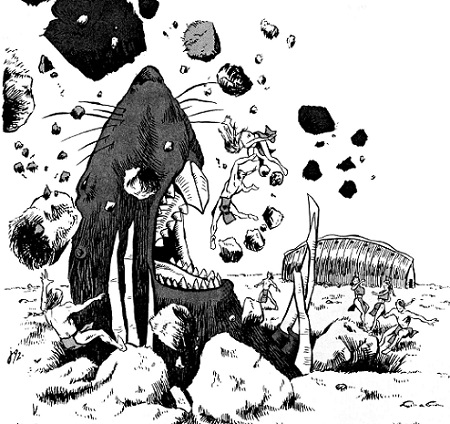 I think this means winter will last forever. The gods of the Madlands are the ultimate source of its supernatural troubles. Though it seems weird to ask if a god can be insane, these ones certainly appear to be; nothing they do is consistent 'cept for Bett Agwo, we'll get to him) and they warp reality around them in unpredictable ways. According to the book, encounters with the gods should be exceedingly rare, usually indirect, and always significantly alter the campaign. Most Madlanders never meet a god, but those that do are invariably marked by the experience due to the gods’ malevolent supernatural power; they should be saved to shake up a campaign or as the capstone to a long sequence. Of course, the way the gods are portrayed makes them so intimidating they seem like they’d ruin a campaign just by showing up; while the book does point out they’re portrayed in such an inconsistent light so the GM can shape them to the situation. While my gut instinct is to keep them out of reach for their character-ruining potential, they do seem to have uses in-game so  Summoning a god to borrow some of their power makes one a shaman, but being a shaman is tough; you can’t often call them if you really want them to come, so you have to clear your mind Zen-style just to get them to come around. Even if you do manage to summon one, getting it to listen to you is a trial; they’re nuts, after all, and even if they decide to help you out they may just gently caress up and turn you into a monster or something. The insanity of the gods extends to their behavior; the GM is encouraged to have rules the gods follow but change them up from time to time, allow them to travel through space and time, and alter their personalities to keep players guessing. The book also suggests they might be beholden to outside forces that modify their behavior, but I feel that cheapens their unpredictability so gently caress that.  Would you like to sign a contract? Bax Powu Kag, the moose, is not depicted above; he has no picture  . He manifests as a weird moose-like animal with grey fur and usually no antlers and he generally avoids humans; nobody seems to know all that much about him because of that. What everyone does know is that he’s a happiness vampire; just entering his presence is enough to inflict depression on humans. His effect is described as stripping people of “all of their mental defenses against the harsh realities of the Madlands”, making his victims sink into self-pity or pessimism, lose hope, and develop obsessive habits and nervous tics. Some people become so desperately unhappy they attempt suicide or just give up, stop moving and starve to death on the spot. Though he’s not the greatest guy to be around, it is possible for shamans to borrow his aura of sadness. If spoken too, he’s just as depressed as you’d guess from his aura. . He manifests as a weird moose-like animal with grey fur and usually no antlers and he generally avoids humans; nobody seems to know all that much about him because of that. What everyone does know is that he’s a happiness vampire; just entering his presence is enough to inflict depression on humans. His effect is described as stripping people of “all of their mental defenses against the harsh realities of the Madlands”, making his victims sink into self-pity or pessimism, lose hope, and develop obsessive habits and nervous tics. Some people become so desperately unhappy they attempt suicide or just give up, stop moving and starve to death on the spot. Though he’s not the greatest guy to be around, it is possible for shamans to borrow his aura of sadness. If spoken too, he’s just as depressed as you’d guess from his aura.Bax Powu Kag is, I think, most useful for turning points in a character’s life. The depression and introspection he causes are catalysts for reflection and can change a character’s life. However, that pressure could very easily go wrong. I guess you could say that for the other gods, though. They all pose issues for use in a campaign, but, eh. Pictured above is Bett Agwo, the Hare. Unlike his fellow gods, Bett Agwo is aware of his godhood, only shows up as a regular hare instead of a giant magic whatever, has a consistent personality, and actively tries to help the people he encounters. He still can’t avoid the supernatural fuckery of the Madlands. Bett Agwo is a twisted wish genie; he’ll listen to any request given by a mortal, grant it, and make them wish they’d never asked. If you want to recover from sickness, you’ll get better before catching something worse; if you want to be invulnerable, he’ll cover you in scales that forever mark you as a monsters. If you ask to never see him again, he’ll take away your eyesight – and that still won’t prevent him coming back since he often shows up in dreams and hallucinations, and since summoning Bett Agwo is as easy as focusing on his name or having unfulfilled needs (excess emotion loving you over is a serious theme in Fantasy II, just you wait and see). The wishes he grants aren’t intentionally harmful, but they’re always negative, so don’t try to find him again and get him to reverse it. If spoken to, Bett Agwo is distracted, wordy, and forgetful, with a low quavery voice. Bett Agwo embodies the Madlander conception that good intentions don’t compensate for bad outcomes, and he’s there to teach that to players. I’m not a huge fan of him since he’s so one-note – he shows up, fucks you up, then gets up and goes, every time – and he’s a bit too much of a gotcha to use on players unless you’re a dickhole. However, he makes a great backstory character and a solid randomizer if applied to NPCs. 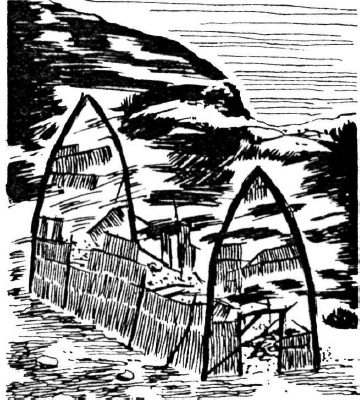 I have no idea what’s going on in the background here. Is it the gods? Though Bett Agwo almost always shows up as a regular-looking rabbit, other gods aren’t consistent in appearance. The way they manifest varies wildly; they might be encountered as transparent versions, disembodied body parts, completely disembodied voices in the woods, normal except for see-through skin showing internal organs, fading in and out, black-and white, shapes with fewer or more dimensions than are strictly necessary, hallucinations or visions, constructed from nearby materials like pine needles or boulders (they sometimes leave these temporary bodies behind as stat), transforming into something else or all of the above. If they show up as something visibly impossible, they inflict insanity Call of Cthulhu-style. Since just being around the gods can bring on the crazy, the book advises you (as I mentioned earlier) to be indirect and have them encounter divine detritus. Some areas look normal, only to turn out to be cursed and slap your characters with disadvantages (please don’t do this to your players). Others are the opposite; though nothing’s actually going on, it might look like some supernatural poo poo is up and inflict the appropriate traumas. Some places inflict emotions on characters relevant to a particular god, while others are occupied by monsters or mutants (there are mutants in this game, I’ll get to them probably next chapter). In the Madlands, even the aftermath of godly presence isn’t permanent; any and all supernatural effects fade with time, but it’s impossible to be certain when, quote, “the spoor of a god” fully wears off. 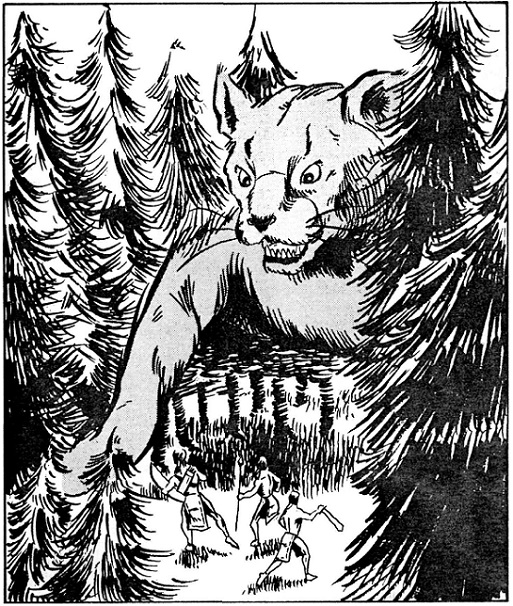 Holding your sword like that just makes you look like a tool, guy. Gakox Pezep, the Cougar, is described as the most dangerous god of all – even though they said the same of Bett Agwo three pages back  . His most notable trait is his split personality; sometimes he’s a polite, gregarious fellow with a raucous sense of humor, other times he’s a wild man-eating animal that destroys everything he comes across – he even destroys things as he travels, taking great leaps that leave craters behind. Which of the two you’re going to get is unpredictable and they can switch at a moment’s notice. The book mentions him razing a village, popping into friendly-form, and asking what all the fuss is about. . His most notable trait is his split personality; sometimes he’s a polite, gregarious fellow with a raucous sense of humor, other times he’s a wild man-eating animal that destroys everything he comes across – he even destroys things as he travels, taking great leaps that leave craters behind. Which of the two you’re going to get is unpredictable and they can switch at a moment’s notice. The book mentions him razing a village, popping into friendly-form, and asking what all the fuss is about. If your characters run into Gakox Pezep, they ought to be real careful; anything from smelling blood to discourtesy can flip him from oh-hey to oh-gently caress, and he’s an unstoppable bouncing force of destruction in the latter. He can be helpful to his shamans and lucky encounterees, but usually he just eats them. Or invites them to a tea party. Either-or. In game, Gakox Pezep mostly useful as a threat of some kind, either menacing the village or stomping something into oblivion and changing the game. Bubzavav is a giant, sentient bear. He’s generally portrayed in Madlander stories as single-minded, eternally hungry, and kinda stupid; he’ll eat grass, mushrooms, deer, honey oh my christ I give up he’s Winnie the loving Pooh. I was going to be so clever and reveal the gods are Winnie the Pooh characters at the end of the chapter but it’s staring me in the loving face. Bubzavav is cheerful and polite (when he’s not cheerfully eating people). Bubzavav is eternally hungry. Bubzavav has “light brown, almost yellow” fur. Bubzavav is described as “roly-poly”. Bubzavav’s stomach and the word “rumble” are mentioned together three times. BUBZAVAV ONCE GOT STUCK IN A HOLE CHASING BEES FOR THEIR HUNNY AND PIGLET FAILED TO HELP BY PUSHING HIM FURTHER IN. gently caress this GURPS Fantasy II, if you can’t be bothered to take your setting seriously I’m out. I hurt my eyes recently and I can barely stand to look at the screen, I’ll finish this chapter when reading things doesn’t make me want to gouge my face out.
|
|
|
|
Serf posted:I'll admit that I laughed at this because I love Big Trouble in Little China. But this and the Buffy the Vampire Slayer stuff really has no place in the book. The latter would be cute if there was a Buffy RPG, but I don't see how it belongs in an unrelated WoD book. Nessus posted:I expect the answer re: Brucato is that Brucato is a big fan of Buffy the Vampire Slayer, but never saw Blade Runner, or at least never paid attention. Not clowns, though. gently caress clowns. Asimo posted:Verisimilitude Also, inklesspen, a few requests: 1: Can you include my name post from last thread in the Madlands writeup? I know its not titled right, but I'd like it in there for completion's sake. 2: Where's GURPS Asparagus? I will not have my finest work dishonored in such a way 3: Treat yourself to something. Having a working archive again is amazing.
|
|
|
|
SirPhoebos posted:I came up with an idea for a WoD game and posted it on that thread, but I thought I'd also post it here since I came up with it from reading all the chat here. Hmm... but one of the key elements of WoD is that your monster-dudes can pass as ordinary people while secretly eating dreams or whatever. How do they hide? Do they use weird super-technology to disguise themselves? For that matter, is superscience their magic-equivalent? I guess one of their struggles would be finding the supplies needed to jury-rig their tech. In theory, you could take the idea of Genius's wonders, reign them in, and standardize them; turning tropes from alien abduction b-movies into powers for your splats that you literally assemble from junk, though eventually they'd fall apart (which is how you'd balance them to keep a Genius-style death ray or cloning machine from breaking the game like an egg). I'm picturing a power-set build on improvisation and urgency; your powers are actually blueprints (or equivalents) you can use during combat/downtime to whip up something useful, but they're prone to fail at dramatically appropriate moments. Tasoth posted:If you were to go back and gut the entire book, Beast could be an interesting basis for a game about free-will. You become a Beast, either by choice or accident, and then you struggle against the dark urges the nightmare in you is calling up. The conflict in the book is between your humanity and the thing inside you. You fight against Heroes who are targeting anyone they find abhorrent, Beasts that have just given up and let the nightmare win, and whatever else you hunt to keep your poo poo together. Even the Dark Mother aspect can be saved by keeping her plans completely unknown but establishing that all the Beasts she is creating are firebombs and monkey wrenches hurled at the God-Machine and anything else trying to dominate baseline humanity. The setup could create tension on so many different levels: keeping people free but using immoral activities to do it, having to choose whether the control another monster is exerting is better than letting the people make up their own minds, do you give in or keep resisting the monster inside you, etc. That could even be used to explain the hostility a chunk of the Beasts feel towards Demons. For that matter, you could spin this a little for the alien thing. instead of being turned into beasts, you get abducted by aliens and turned into one of them so they can keep their numbers up. You struggle to choose between empathizing with humanity and following the inhuman call of your alien creators (morality stat!), fight against the WoD bullshit that followed your creators here, replace the Dark Mother with said creators fused with Talsoth's idea and have them setting loose you and your comrades to throw up a smokescreen of destruction and shenanigans they can hide behind, etc, etc, etc. Also, Leviathan from earlier in the thread. I agree that it looks cool and a lot more structurally coherent, but, uh, there's a lot of  in the current documentation. Like, breeding in the current documentation. Like, breeding  . I know a lot of that sort of thing comes with the territory here, but they barely bother avoiding it. . I know a lot of that sort of thing comes with the territory here, but they barely bother avoiding it.
|
|
|
|
Oh man, every further post in this thread makes me happier I chose not to read that review.
|
|
|
|
Kurieg posted:Hey Sorry, man; I have some issues and triggers of my own and I made a habit of avoiding stuff that sets me off. However, I am enjoying the discussion your review sparks and each post adds new depths to the arguments, so in that way its worth it 
|
|
|
|
Mors Rattus posted:
I may regret asking this question, but: why? e: especially when Baphomet is present to set off the 'phobic crowd
|
|
|
|
wiegieman posted:Anyone who wants to do Glorantha would have to first pick which Glorantha RPG to do, and if they picked the older ones they would have to find a bunch of rare-ish books. There's only two or three books for the current heroquest release, with the new runequest coming. That, or they'd have to summarize the Guide. I dunno, I've never been a fan of dissecting rules instead of going rear end-deep into weird settings; it's why I (partly) did Madlands without touching on GURPS rules. Hell, I might try to do some kind of readthrough of the Guide! Lessee, the first half of the guide is... 398 pages
|
|
|
|
Alien Rope Burn posted:Yeah, I've gotten halfway through it before I just went limp and started emitting steam. Kralorela broke me. After all those interesting, unusual interpretations of real-life cultures, I wanted to fall in love with GlorChinatha. I, uh, the opposite happened.
|
|
|
|
GURPS FANTASY II 5.5 – MORE GODS It’s been a goddamn long time since I made the last post and Madlands is complicated and involved; you may want to check the archives and skim the rest of the review before reading. Or don’t. Or ignore the post  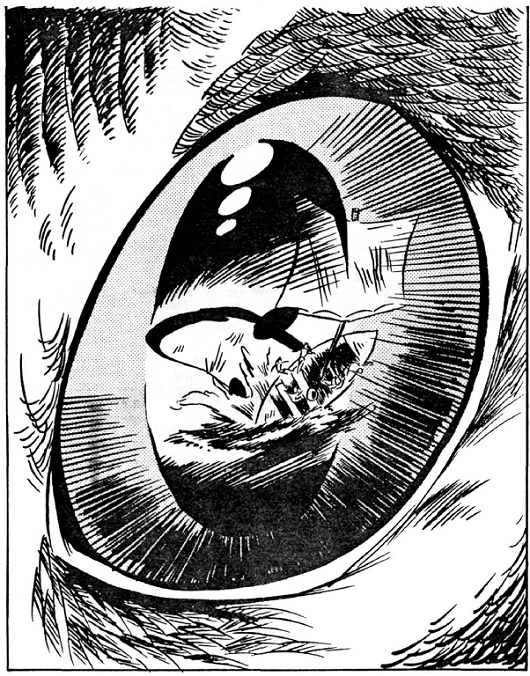 Madlander TV is pretty wild. Vuvuti, like many mythical owls, represents knowledge and wisdom. Vuvuti, like all Madlander deities, represents poo poo you want to stay away from. He tends to manifest as a big honking horned owl, usually human-sized, with massive dishpan eyes. If you come too close to him, your gaze will slowly drift towards those eyes – and in them, you’ll see something that fucks you up. Sometimes, you see an image of your doom; sometimes, what you see causes a realization so horrible you go crazy; sometimes, you learn a secret that’s dangerous to act on – how to become a shaman dedicated to him, for example. As far as Madlander gods go, though, his particular brand of shamanism is light; in exchange for the ability to see the future, find hidden objects, and learn secrets, he just wants to peck out your eye. Every power he grants you comes at the cost of a body part, but that’s all Vuvuti wants from his shamans; you don’t get the tasks and personality bleed you might from other gods after signing up. In Madlander stories his personality is unclear (he never talks), but he’s said to have “a jeering contempt” for humans; he’s also, you know, an owl, and he hunts like an owl does, including hunting human children (not like an owl does). As far as Madlander gods go, Vuvuti is pretty good for games; his visions are great for sparking quests to save doomed villages or go adventuring deep into the Madlands, while his shamans make great villains. Since they only have to give up body parts with no further strings attached, Vuvuti shamans have freedom of movement and incredible intrigue potential; the only way to identify one (aside from catching one casting a spell) is to look for lost body parts, which are pretty common in a place as dangerous as the Madlands. Until then, the shaman has spells that can tell them who’s after them, what they know, and how to gently caress them up, but typical Madlands magical corruption gives them reason to slip up enough that the PCs can outsmart them. A-, would use. Madlands gods, for all their inherent violence and insanity, seem to actually get along pretty well. According to the storytellers, when they show up together the gods usually act in some kind of parody of Madlander behavior; they’ll race beetles, play that sticky-fish game from earlier (and occasionally temporarily kill each other with sticky killer whales), go on picnics, or just have conversations. Sometimes they’ll play pranks on each other or use their powers on eachother, always to disastrous results. You’re still as hosed as usual if you run into them when they're hanging out. 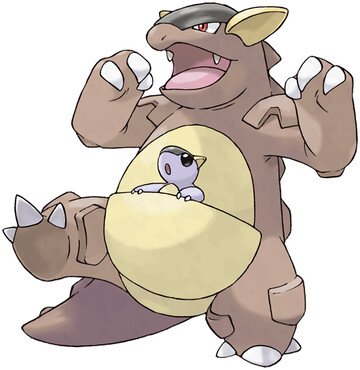 The book doesn’t include pictures of them, so here’s a highly accurate depiction of Kikavo Vo and Kikavo Dat from the internet. The Kikavos are unique among gods; they don’t resemble any known animals, they have an obvious familial relationship, and Kikavo Vo is the only female goddess. In the stories, their appearance is consistent: ”GURPS FANTASY II: Adventures in the Madlands” posted:[T]hey have the heads of deer (without antlers) mounted on long thick necks. Their chests and torsos are like those of big potbellied grizzly bears. Their postures are upright, like a man's. Mounted on their shoulders are tiny arms like those of a small child. On the end of each arm are the sharp claws of a wolverine. Their powerful legs are designed like a toad's, but their huge feet resemble those of no known beast, long and flat like planks from a ship deck. With these fearsome appendages they bound across the landscape, leaping miles at a time, smashing anything they touch down on. They anchor these leaps with a thick tail, resembling a shortened squid's tentacle, protruding from their hindquarters. Their freakish bodies are covered from head to toe in thick brown fur like a moose's.  Kikavo Vo, the mom, usually tries to be nice; of course, being a Madlands god, she’ll "help out" by dissolving your broken bones or smashing your burning house flat. The only time she gets angry (as opposed to her normal malignant benevolence) is when Kikavo Dat, her Kikavo Dat is specifically described as a sadistic seven-year-old with phenomenal cosmic power. He’s hyperactive as hell and spends most of his time running around and loving with things, often catching people and taking away parts of their essential natures just to see what happens. You can reason with him to get him to stop, sort of, and you can sometimes keep him happy until he gets bored and hops away (or he’ll turn your balls to butterflies); either way, you might catch his ADHD like the flu, get akathisia, or even regress to childhood. Some stories have his shamans turned into kids or just be children straight-up. I’m not a huge fan of the Kikavos. They just don’t do jack as far as stories are concerned; everything Vo does is covered by another god, while Dat’s association with children is just uncomfortable. I’d avoid them if you want to put a Madlands campaign together, but, well, whatever. 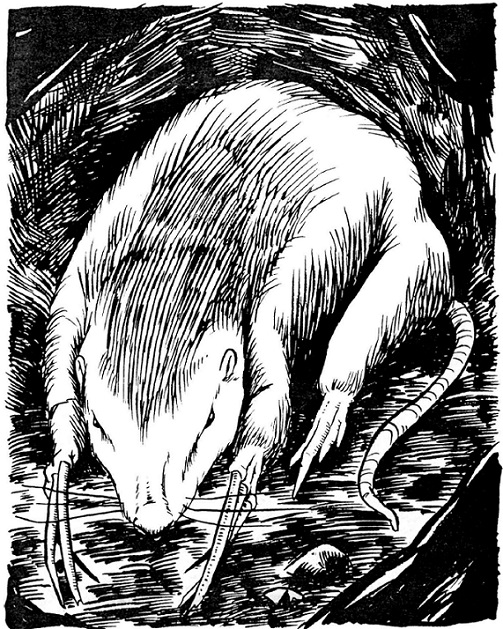 Aww, lookit dose widdle claws Madlanders don’t see Zewa Zab much compared to other gods (not like the gods are common), but they do stumble across his tunnels constantly. He’s described as a gopher, which in this universe means he spends all of his time digging tunnels through the landscape; he doesn’t seem to give a poo poo about anything else, to the point where stories involving him have him talk about only tunnels at lightning speed. His tunnels might follow a pattern, or they might be random, or some mixture of the two (nothing is mutually exclusive for Madlands gods), but nobody knows because nobody risks haunted tunnels or godly attention to enter an unexplored tunnel network. As far as gods go, he’s pretty harmless; sometimes he’ll eat people in his way or nab a tuber harvest on his way to wherever he goes, but he usually ignores you otherwise. Hooray for lesser evils! Not for his shamans, though. They use tons of earth magic and hide out in his tunnels when not doing whatever it is shamans do in their free time. Zewa Zab, game-wise, is mostly useful as a background character. His tunnels make reasonably good hiding spots for various monsters and his shamans make for solid opponents with ready-made hidey-holes. What else can he contribute to a campaign? Nothing! Least as far as I can tell. So, gods are pretty rare as far as encounters with Madlanders go (most Madlanders never meet a god); also, if they stuck around all the time they’d have driven everything extinct a long time ago. So where do they go? Nobody knows, of course! Storytellers can’t agree on this, which is probably a good thing, since someone who knows where the gods live is probably a shaman. The book forwards theories about them living above the clouds in some kind of heaven/hell, distant realm beyond even the Whiteness, a pebble in the Madlands interior, or some cold, dark place where dimensions shift constantly (the book connects this to the Soulless, one of the weirdest parts of GURPS Fantasy II). One story has a shaman philosophizing that the gods are quantum particles and only exist when folks want them to deep down, but his speech is cut off mid-sentence by Zo Do Wabda, natch. GM’s can choose one or more truths; as I said earlier, nothing is mutually exclusive for Madlands gods. The last god in the Madlands is Zuutak, the only name (or word) in the entire Madlander language to use a double vowel. Why? 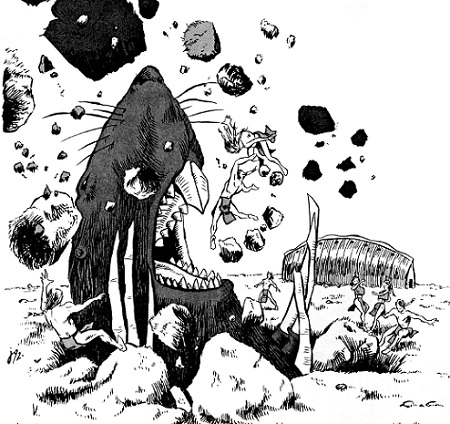 That’s why. Zuutak is a giant pig that loves crops. Which is great, because he’s the most likely god to show up in a village. The double vowel in his name is the speaker shouting a warning to everyone within earshot. While tubers aren’t necessarily the most valuable food source in Madlander society, they’re a key source of flavoring, alcohol, and most importantly, nutrients. If Zuutak swings by, your entire tuber crop, months of hard work for your alcomahols, is hosed (also possibly your tuber storage and wavobeks if he feels like it). But that’s not the worst part. Like any god, places Zuutak visit tend towards plagues of monsters and hauntings. Unlike any other god, Zuutak mostly shows up in villages (though he occasionally wrecks stretches of landscape hunters stumble upon). The book doesn’t touch on this, but if those parts of the wilderness Zuutak fucks up develop paranormal bullshit, the same probably goes for villages! A Madlander village sits on a razor’s edge in the best of times; the destruction Zuutak leaves in his wake, even if he just eats some crops and disappears, might just be enough to scatter the village entirely. According to the book, a village has 11-13 clans, each with 50-75 members in its extended family. This means the minimum population of a village is around 550. The total Madlander population, also according to the book, is around 25,000; therefore, there are, at maximum, roundabout 45 and a half villages in the Madlands. And, once again according to the book, Zuutak attacks “only one or two villages a year”. Granted, this is math applied to population figures in a game world, so its naturally hosed and probably inapplicable. But if it is, that means most Madlanders see Zuutak at least once in their lifetime! And some encounter other gods too! And the book says most Madlanders never see the gods once in their lives! If I had to guess, it’s just a minor math error a GM could handwave away or straight-up miss while reading this section through. There’s little else to say about him; he doesn’t show up much in Madlander stories, and his shamans mostly spend their time stealing food from villages like a grimdark cartoon robber. Zuutak is, I suppose, mostly useful as a threat or source of anxiety for campaigns; did the next village over get hit by Zuutak? Did a friend of yours run into him disguised as a normal boar in the woods (according to the book, no matter what size Zuutak is “all of his destructive power remains intact”; imagine running into a boar that can gore a person with enough strength to crush large buildings  ). I can’t imagine using him as much more than that, you don’t want to kill your characters too fast. ). I can’t imagine using him as much more than that, you don’t want to kill your characters too fast.Incidentally, this creature associated with anxiety will sometimes show up as tiny and bright pink. I can’t imagine why  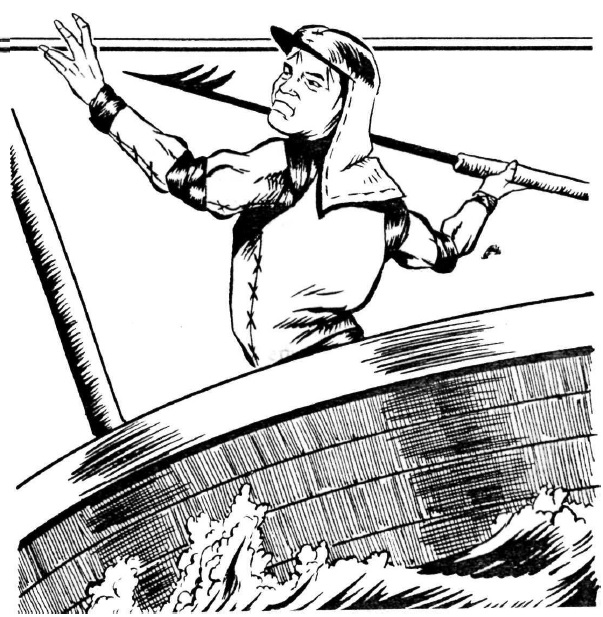 This chapter has run out of pictures, so have Popeye’s angry cousin next to rules for training beetles. A dirt-average character needs to spend 8 out of 100 starting points to successfully train a beetle more than 2/3 of the time! :gurps: Before we leave the gods behind, it’s worth quickly noting that their domain is limited to the Madlands; foreigners unfamiliar with the Madlands tell the locals they’ve never heard of the gods (the book doesn’t note whether the xenophobic and suspicious Madlanders would believe them). No god can travel beyond the coastline under any circumstances, but the book doesn’t say what happens if a god approaches the coast chasing someone which I imagine would be important if it happened in game but  . Nothing, at all, supernatural crosses the shoreline; gods don’t, monsters don’t, shamans can but their powers don’t work. What happens if you bind up a monster and load it onto a fishing boat? Good question! That’s probably a terrible idea, though, so that’s unlikely to come up in game. As it so happens, this border stretches around the Madlands across land borders with other cultures as well; the mountain range that divides the Madlands and Togeth and an indistinct line somewhere up in the Whiteness also seal out the supernatural, sort of, though those seals aren’t as impermeable as the sea. Some gods and monsters can cross them sometimes, but they avoid doing so if they can for whatever reason. . Nothing, at all, supernatural crosses the shoreline; gods don’t, monsters don’t, shamans can but their powers don’t work. What happens if you bind up a monster and load it onto a fishing boat? Good question! That’s probably a terrible idea, though, so that’s unlikely to come up in game. As it so happens, this border stretches around the Madlands across land borders with other cultures as well; the mountain range that divides the Madlands and Togeth and an indistinct line somewhere up in the Whiteness also seal out the supernatural, sort of, though those seals aren’t as impermeable as the sea. Some gods and monsters can cross them sometimes, but they avoid doing so if they can for whatever reason.Alright, Chapter 5 is over. The whole section’s utility in gameplay is questionable; the gods are good for setting background and some story seeds, but every single one of them is powerful enough to wreck campaigns if your GM is sadistic enough to set up a godly encounter - and, of course, the forethought that characterizes a lot of this book wore out near the end because even the authors started to figure out this part wasn’t worth the effort. Meh, I guess. I’d complain about wasted page space, but my copy is a 31-meg pdf so who cares. It occurs to me that, since GURPS is (obviously) the complete wrong system for Madlands, PbtA would handle it a hell of a lot better. Or maybe some kind of King of Dragon Pass mod. That’d be neat! Next time: 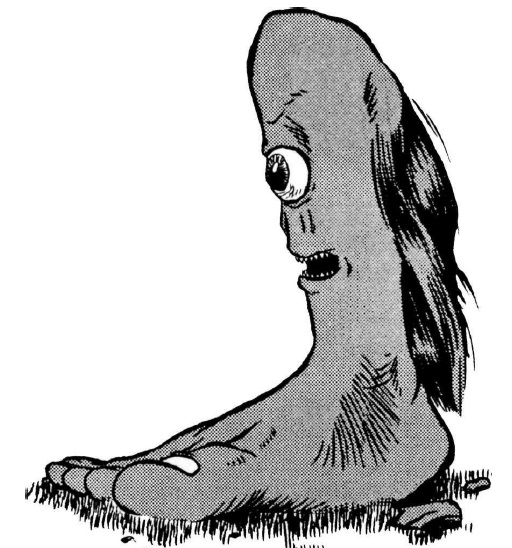
|
|
|
|
The Lone Badger posted:Why the gently caress do people live in the Madlands again? Because they're born there. And their family and friends are there. And they think anyone from anywhere else is crazy (they aren't).
|
|
|
|
Josef bugman posted:Speaking of things set in Glorantha that are coming out soon(ish) check out the art work on Six Ages: http://sixages.com/blog/ 
|
|
|
|
GURPS: MADLANDS 6 – MONSTERS 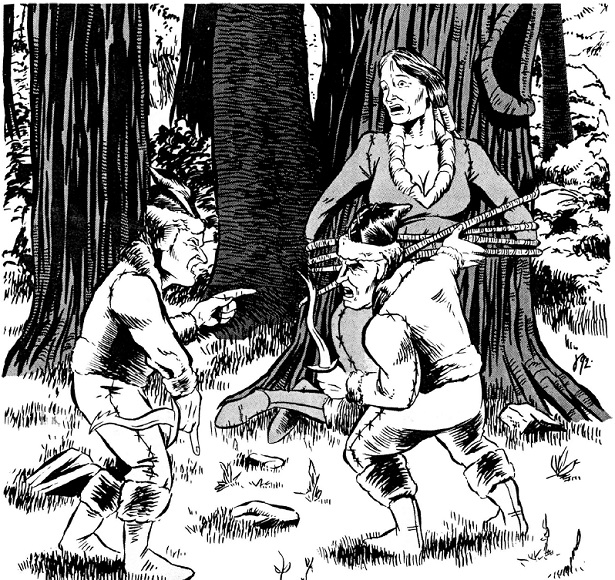 Santa’s elves finally stage their rebellion. The gods of the Madlands are distant, alien, and rarely encountered. The monsters of the Madlands are none of those things. In general, hunters will encounter one of these things at least once a year, possibly more, which is bad because their stats are loving bonkers to a man. Monster. Monster-man. While the gods symbolize Madlander failings in a more abstract, generalized way, monsters hit much closer. I could go through the gods without delving into what they mean in Madlands culture. I can’t describe any monster with describing what happened to him or her first. Yes, “him or her”. Every Madlands monster used to be a human being. Madlanders view monsters in terms of what they’re missing; while each creature lacks some part of a normal human’s body, they also lack a part of their basic humanity, something that holds their minds and morality together. This, by the way, is part of why few Madlanders fear a violent death: it’s one thing to pass out of the world in violence; it’s another to be bound in your body afterwards, insane and animalistic until something takes you out of the world by force. To Madlanders, society is literally built into human blood, and becoming a monster corrupts your blood and makes you incapable of social function. The book goes out of its way to say this theory is a best flawed, though, so  . Still, all monsters are anti-social in the “actively destructive to others” way. . Still, all monsters are anti-social in the “actively destructive to others” way.”GURPS Fantasy II: Adventures in the Madlands” posted:Monsters are no more capable of self-sacrifice or compassion than a chipmunk is of flying. ”GURPS Fantasy II: Adventures in the Madlands” posted:Since anyone who dies without being given a proper funeral becomes some sort of undead menace… Anyway, any victim of a god attack will turn into a monster depending on what body parts they lost; there isn’t a huge stable of them to pick from, but it’s enough to cover most possible bizarre deaths. The transformations aren’t consistent between death, naturally, so people killed one way might turn out differently. That way you can’t be prepared! The gods seem generally friendly to monsters and won’t seek them out for violence, but if they do get attacked, they’ll turn into different monsters. That way they can’t escape! You’re advised to treat monsters less like DnD and more like horror movies. Even the shittiest monster can go toe to toe with experience warriors and their appearances are disturbing enough to force a SAN check. Build up slowly, drop hints, describe a trail of destruction, show victims; make a monster as intimidating as possible before the party encounters it. The book tells you not to pull any punches if your players charge organ-skeletons willy-nilly and to “show no mercy” (and this for characters that can die if a thrown rock happens to crit). That’s kinda bad! The book then tells you always leave a way for players to escape! That’s better! The book also tells you to make your players pay close attention to their surroundings and situation (/read your mind if your bad at describing them) in order to escape. That’s kind of neutral I guess! Disclaimer: This review was prepared by Falconier111 in his personal capacity. The opinions of monster meanings expressed in this article are the author’s own and do not reflect the views of Robin D. Laws, Steve Jackson, or Steve Jackson Games Incorporated. 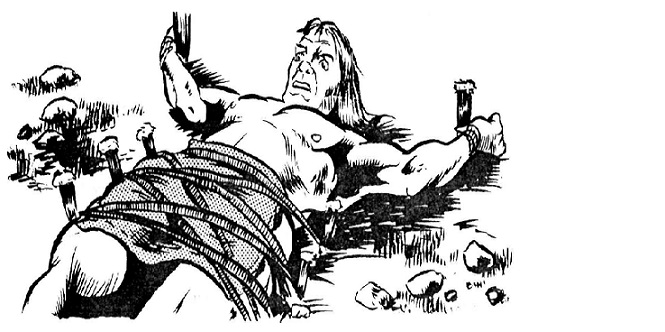 I have the weirdest stake right now. Bloodless are vampires in constant pain that can only be solved by human blood (not animal blood, this was before Twilight). If they spend too long without said blood they turn all gross and ghoulish and their skin dries out to the point that sometimes their noses decay and fall off (they have to bandage their face or all the blood they drink will spray out their nosehole  ); additionally, their intelligence will start to permanently decline until they become pseudo-zombies. To wit; ); additionally, their intelligence will start to permanently decline until they become pseudo-zombies. To wit;”GURPS Fantasy II: Adventures in the Madlands” posted:The more brain-dead ones may have little to say beyond "Blood! Blood! Blood!" Three ways to become bloodless; gods, contagion, and misbehavior. As mentioned earlier, any encounter with a god that removes one’s blood (Dopod Abwep boils it away, Gakox Pezep drinks it, Bett Agwo turns it into butterflies, etc.) turns one into said monster; bloodlessness also spreads to dead victims, which is why smart bloodless return their victims to their communities. Greedy and cowardly Madlanders can also become bloodless eventually. At first they’ll get good and gluttonous, then they’ll need to eat enormous amounts just to stave off hunger. Finally, they’ll see someone shed blood, go crazy from thirst, and kill the person before fleeing into the wilderness. But, before that point, community interventions and behavior change can fully reverse the process, a theme that’ll keep coming up. Bloodless are parasites and represent parasitic people; it’s why they evolve from the greedy instead of the outright predatory. Bloodless consume their victims like gluttons and cowards consume the village’s resources without giving back. 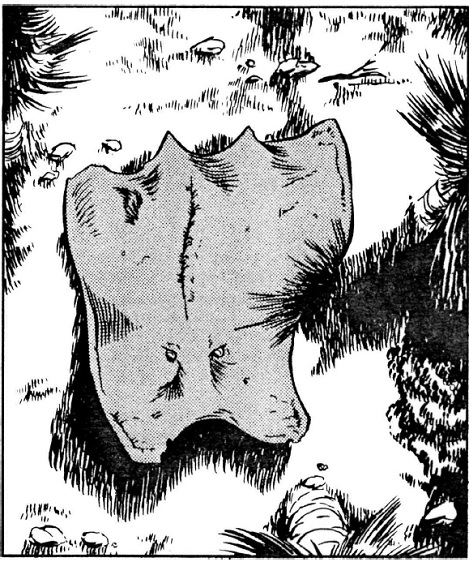 Let’s name the monsters, the monsters, the monsters; let’s name the monsters of the Madland sea! Boneless are… well… they aren’t ”GURPS Fantasy II: Adventures in the Madlands” posted:The boneless are great flopping sheets of skin that fly the Mad Lands' interior in search of prey. They move through the air as a manta ray swims through the ocean. Their hides match the complexion of Madlander skin. A pair of human-looking eyes is mounted front and center on its top surface. Anyone foolish enough to closely examine a boneless will discover vestigial remnants of its original human form scattered randomly about its hide - an ear, a few teeth, some hair, a nipple. Along its underside they'll find hundreds of enlarged pores about a fifth of an inch in diameter. In living specimens each pore will be sealed with a layer of yellow mucus.  but meaningless illusions! Naturally, victims might get phobias or nightmares related to blankets, being smothered, or acid. but meaningless illusions! Naturally, victims might get phobias or nightmares related to blankets, being smothered, or acid.Boneless are also excessive consumption, but turned outward instead of inward. A hunter kills more than he can carry, a fisher throws harpoons fish and throws them back to pass the time, a boneless that mindlessly consumes people; these are similar to a Madlander’s mind. Taking from the environment for no purpose will weaken it and, eventually, you. 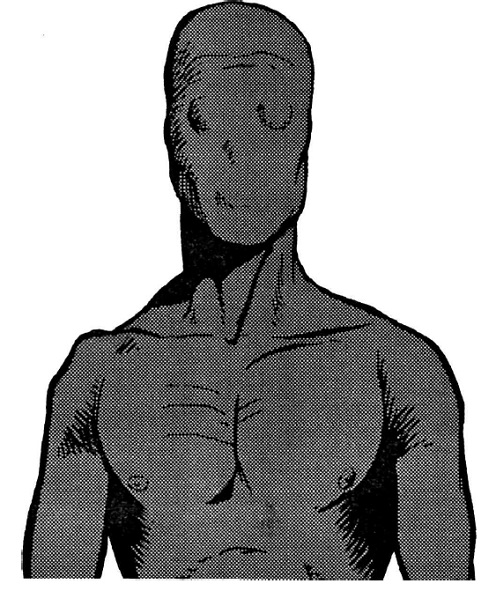 Even in death I'm still ripped. Faceless exactly resemble ordinary humans except for their face; it’s not that they lack ordinary facial features, but they have a layer of flesh completely concealing them. Unlike the last two monsters, they don’t want to harm humans; they’re lonely and they just want to be your friend ”GURPS Fantasy II: Adventures in the Madlands” posted:Secondly, faceless are relentless once they decide to follow someone. Even hacking them apart doesn't stop them. If a faceless' legs are chopped off, it'll pull itself forward with its arms. If its arms are removed, it'll edge along on its stomach muscles like a caterpillar. If decapitated, its head will roll towards the one it seeks. If the skull is cracked open, the exposed brain will crawl out and creep on ahead. Other severed parts may also continue the pursuit: one victim may be pursued simultaneously by a faceless' head, both arms, torso, legs and ambulatory entrails. Each part carries the same degree of bad fortune as the whole. Faceless are solely god-generated – Dopod Abwep will burn your face off while giving you a hug , Bax Powu Kag can sad your face off apparently, Gakox Pezep, Bubzavav, and Zewa Zab might bite your head off because that counts as not having a face. Psychological damage after a faceless encounter could include paranoia based around being followed, phobias of losing facial features, or hallucinations of others’ faces melting away (possibly followed by violence towards them). Faceless are those who rely too much on their neighbors. While bloodless-analogues intentionally exploit the efforts of others, faceless-analogues don’t want to be a bother. However, they’re so emotionally reliant on others they lack the confidence to contribute anything to the village. Whatever faceless-analogues do contribute, their efforts lack dedication and focus as they seek approval from others over actual skill. 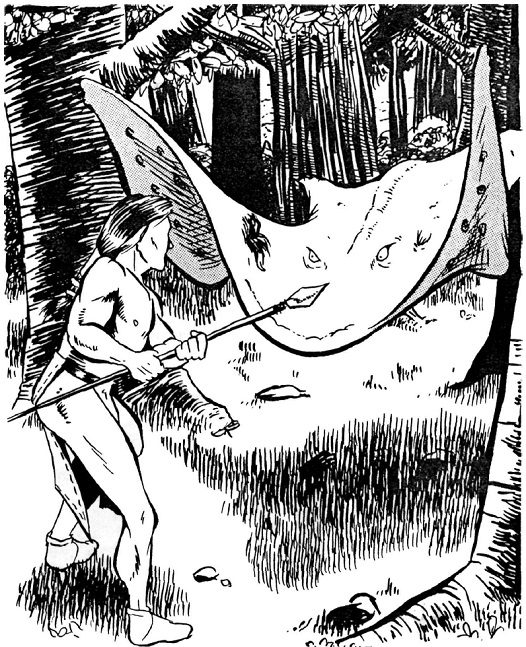 I couldn’t find a fleshless picture so have another boneless i guess. It’s kind of a shame fleshless don’t have a picture as they’re one of the weirdest monsters in the book. Just like their name implies, they lack skin and muscle, but everything else is still there; their eyes, internal organs, tongues (yeah, I know the tongue’s a muscle, that’s what the book says), and even nerves dangle loosely from their skeletons. Their psyches are split by two equally powerful urges; they emotionally want to be human, and they instinctively want to destroy every human they meet. If they encounter a human in the forest, the fleshless will try to convince the human they’re human while the human tries to convince this human they know they’re human until the (real) human either gets away or lets lit slip that the fleshless is actually an organ skeleton and gets ripped apart. Fleshless don’t even want to hurt other humans; but if they get pissed off enough, fleshless will berserk and kill people (though most fleshless are made by god-fuckery, fleshless can spread fleshlessness by mutilating their victims – itself a rare occurrence as, again, fleshless don’t actually want to hurt people). To hold on to their humanity, fleshless cling to what used to define them with such intensity they become caricatures of their former selves, which doesn’t endear them to anyone; despite this, fleshless often form their own communities and try their best to live ordinary lives. Fleshless will build “wavobeks” (lean-tos), form clans, get married, play games, tell stories, and even compete to adopt any fleshless kids who stumble along (a few will actually kidnap human children and rip them apart so they turn into new fleshkids  ). They can’t, though. Fleshless perceive other fleshless as human enough to want to kill them and their social structures rip themselves apart in a storm of violence in a year or less. While the book definitely doesn’t state this, I’d say that the fleshless urge to kill grows stronger with their relationships; even as they form genuine connections with others, their homicidal urges increase and wear on their minds, straining the relationship until it dissolves into violence. Fleshless will never emotionally connect with anyone until the end of their bodies or the end of time ). They can’t, though. Fleshless perceive other fleshless as human enough to want to kill them and their social structures rip themselves apart in a storm of violence in a year or less. While the book definitely doesn’t state this, I’d say that the fleshless urge to kill grows stronger with their relationships; even as they form genuine connections with others, their homicidal urges increase and wear on their minds, straining the relationship until it dissolves into violence. Fleshless will never emotionally connect with anyone until the end of their bodies or the end of time  . .Fleshless are loving hard to kill; the only way to hurt them is to smash their bones, an epic task since they have several times as many hitpoints as ordinary humans. Survivors might begin to doubt that they’re actually people, or think others are impostors in human skins (the Capgras Delusion, which hits a little close to home as my grandmother is going through it), or rapidly gain or lose weight (I don’t get this one). Fleshless are those who seek to prove themselves at the expense of the community – Madlanders aren’t friendly towards those with the anti-magic barbarian equivalent of Impostor Syndrome. If a person feels they don’t belong and try to compensate by being too helpful, they do the opposite of contributing and end up hurting the village.  Dude, the feminist-government-Jews obviously used Obama’s fake birth certificate to put chemtrails in our GMOs. Just check out my blog for proof! Fleshless qualify as one of the Madlands’ weirdest monsters, but that title probably goes to the Footless. Why are giant feet called footless? Madlander humor! Footless are an impressive eight feet tall and three feet long, and though they have an eye, mouth, and nostrils, they have no internal organs. They smell like feet if you get up close, of course. Footless are thought to be intelligent but universally insane; they behave unpredictably around humans and don’t do much when left alone. If you get close, you’ll hear them talking to themselves about random things – except everything they say is correct in some fashion, whether they’re talking about foreign culture, the gods, or even the listeners own thoughts. According to legend if you listen to them one single piece of important knowledge will be buried in their monologue, but good luck finding it! Footless are only created by gods; Kikavo Dat likes to shape his victims into footless, though other gods might make them by eating off someone’s legs. Victims of footless find they’ll attack with a (lovely) bite or a (way more powerful) goomba stomp, or get slapped in the face by sorcery. Sorcery in the Madlands, by the way, is weird and associated with the Soulless, another monster type that gets a whole chapter dedicated to it. Look forward to insane immortals! Survivors might think they’ve been cursed with shamanic powers (footless don’t get shamanic powers), become obsessed with whatever they heard a footless babble, or smell only the pungent odor of giant magical feet for the rest of their lives Footless are those who become obsessed with learning. Madlander culture regards innovation with distrust as it might attract attention from the divine; innovators and inventors not only flaunt this taboo, but waste valuable resources in experiments and even establish accidental rituals that justify the taboo by bringing supernatural forces around for a look-see. Non-traditional knowledge is inherently dangerous in the Madlands, and pseudo-footless embody it. Next time: headless ogres!
|
|
|
|
Alien Rope Burn posted:People have asked me and I'm not planning to, given I'm already neck-deep in classic Rifts reviews at the moment, but I posted some quick impressions on it over in the Palladium thread. Overall, it's generally positive, has better rules and more robust character choices, but also has a lot of (IMO) unnecessary random tables and combat can get really rocket-taggy, even for Savage Worlds. That is the most terrifying thing I've ever heard. I've ran Savage Worlds exactly once because I had to start fudging roles just to keep my party from insta-killing minibosses with random exploding dice. And speaking of insta-killing... GURPS FANTASY II 6-2 – MORE MONSTERS 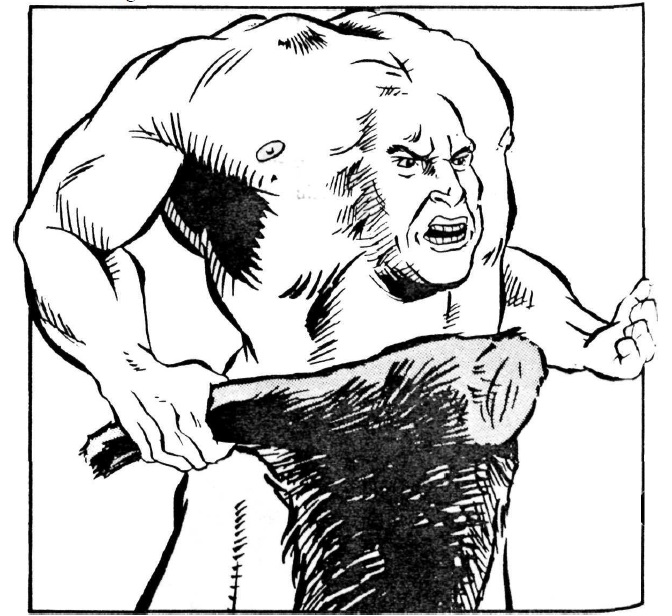 These new steroids are amazing but man, do they ever have side effects. Headless look kind of like normal humans except for, well, having no heads and faces in the middle of their chests. Unlike normal humans, headless aren’t intelligent in any meaningful way. The only way they deal with the outside world is through violence against anything moving; animals, monsters, swaying, waterfalls, the gods. They don’t think about it, or anything else; they just use any weapons they had in life – or pick up boulders or trees – and use them to beat the poo poo out of things. Though headless can’t communicate in any way, they do gather in small groups and like to go a-rampaging, often targeting and destroying villages. Headless are created when gods smash someone’s head through their body; the Kikavos and Gakox Pezep are prone to this. If they do have shamanic powers, they can’t use them and can’t even let off random sparks like boneless. Survivors of headless encounters might begin to fear crowds, develop delusions that their chest is growing a face, or begin emphasizing their individuality to irritating extents. Headless represent mindless violence. A headless-equivalent approaches all problems with aggression and force, only for it to backfire when an attack goes wrong. Those who resemble headless in mind leave a trail of destruction in their village like headless in body. 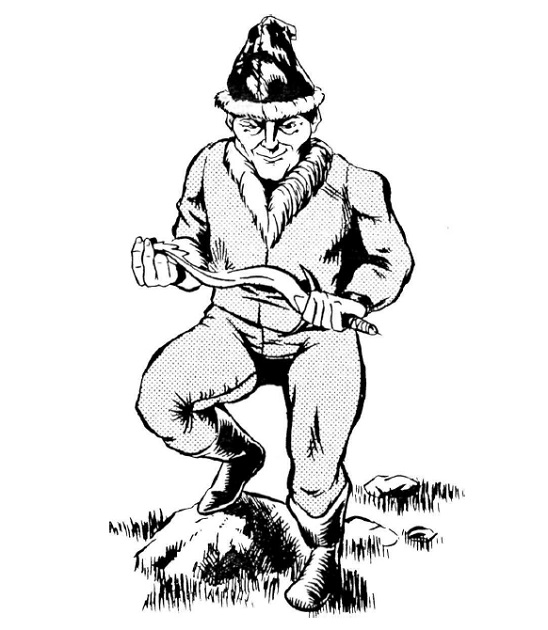 The second-worst elves in the book. Ever heard of a redcap? No? Then how about a serial killer? Heightless are both. A few come from people smashed flat by gods. Unlike most monsters, however, most heightless originate as Madlanders. Occasionally, a Madlander will get away with murder. Such people, when they realize no retribution is coming, and even if the original murder was an act of passion, start to feel the impulse to kill again, and usually eventually succumb. As they transform into a proper serial killer, they begin to consider themselves geniuses and physically shrink (usually to something between 3 to 1 feet in height); eventually, they’ll have to flee the village before their neighbors realize exactly what they’ve become. Heightless don’t kill humans for any emotional reasons (though murder does help them survive). They consider it an art form, choosing victims based on some twisted pattern and torturing them in some deeply hosed-up pattern before they finally expire. Heightless are solitary creatures, though if they do run into other heightless they’ll usually companionably share stories of serial killing before heading on their way; their most common “social interactions” are with people who won’t be capable of them for very long. In fact, these “social interactions” are vital for heightless – as long as they kill at least two humans a year, heightless can only die in one way. Sometimes this way is a standard way of ending a life, but other times it’s something just plain weird; the book gives beetles crossing their left boot or getting hit in the face by a robin’s egg as examples. Otherwise, damage won’t affect a heightless in any way, shape, or form. The standard way of getting rid of heightless otherwise is to wrap it in a net and through it somewhere it can’t escape long enough for it to expire in human style because a lack of murder took away its immortality. For reasons unspecified by the book, all heightless wear felt caps they dip in the blood of their victims (redcaps lol). Also unspecified is what they do if they encounter other monsters, which would be nice to know. Psychological damage from a heightless usually hits a whole community, as heightless themselves aren’t particularly scary-looking but they tend to target multiple people. They’ll grow scared and angry, often forming witchhunts against innocents. Those who somehow survive a heightless attack will likely suffer PTSD. Most don’t; heightless are scary. Becoming a heightless significantly boosts a character’s physical skills and wildly boost their mental skills; though I won’t get into how and why this works here because gently caress GURPS’s mechanics, but trust me, this makes them plenty dangerous in encounters when added to their, you know, invincibility. In the villages of the Madlands, no person is truly irreplaceable. The heightless back up this notion by attempting to refute it. From a heightless’s point of view, they are geniuses and ordinary people like ants; to ordinary Madlanders, heightless are insane sadists. Elevating yourself above others through skill and intelligence, though our culture often prizes it, is dangerous and destructive in the Madlands. 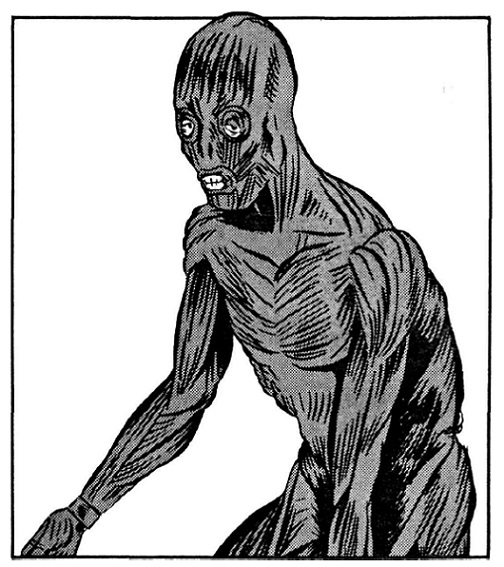 God, eyelid muscles are just the worst. However, of all the monsters in this chapter, skinless are probably the most dangerous – not because they’re deadly in combat (though they are) or they have shamanic powers (though many do), but because they combine both of those with a human intellect. Skinless lack, well, skin; their muscles are exposed to the open air and encircled by pulsing arteries and veins, and many have bags of glistening fat that hang off their bodies Skinless, again like humans, gather with other skinless and form social structures. They tend to gather around charismatic leaders who organize their troops in whatever method pleases them, often leading them in raids against human villages and sometimes trying to form vast skinless empires. In the warm(er) months, these communities live in makeshift camps and hunt in the surrounding forest; in the winter they go into caves and hang out near fires because cold makes them sluggish and exacerbates their pain. Skinless groups often have access to shamanism, whether obtained from the god that killed them or taught and passed down by other shamans (they are the only group in the Madlands that openly teaches shamanism), but they do have a unique form of magic – skinning. Skinless can capture humans and conduct a ritual in which they ritually skin their victim, taking their epidermis whole. If they manage not to go into shock (easier in-game than in real life) they become a skinless! Yay Though some skinless are born this way, most are either created by the gods (their skin gets eaten off, burned off, magicked off, etc.) or through social dysfunction. Being too self-centered, whiny, or easily offended can turn a person into a skinless, I guess because selfishness is bad? I don’t see the connection. Those that fight skinless and make it back to the village might begin to suspect others are skinless in disguise, suffer psychosomatic pains, or start to think their skin is about to peel itself off of them and wander off. Most monsters deal with individual issues, but skinless reflect the moral collapse of a community. A skinless community is the dark reflection of a Madlander village; cooperation is replaced by domination, prudence by heedless exploration of shamanism, creation by destruction. The foul acts of the skinless are a warning against any weakening of the bonds that hold Madlander society together. 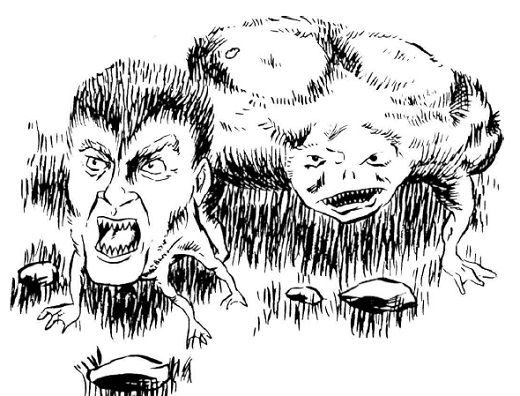 Wolverine’s healing factor finally went too far. Soundless are called soundless because they move without making a sound Soundless in combat aren’t insanely tough; their chief threat is the fact that they automatically succeed at stealth checks and can paralyze you in combat (it takes weeks to full recover from it). Survivors of such encounters might feel like they’re being followed or like their bodies are about to actually fall apart. Soundless represent subterfuge. A sneaky, dishonest person is a threat to their community as they hide and appropriate its resources for themselves. A soundless hunts men as a liar hunts resources; both can cost the village dearly in times of want A weightless on a cloudy day.This is the laziest thing I've done in this review. Yet. Weightless are the saddest and least threatening of all Madlands monsters. In the right light, weightless look exactly like ordinary people. In the wrong light, they are revealed as spectres with no ability to interact with the world. At any one time, a weightless can influence two senses but not the three others; you can see and hear them, or smell and taste them I guess. Except one of the five senses is touch, so  . Some weightless go nuts and try to hurt ordinary humans, but most remain sane(ish) and only want to talk to others and be less lonely; sadly, Madlanders shun them because they can’t tell the difference and can’t trust them to tell the truth. Most weightless end up wandering the wilderness in forlorn depression, eventually seeking out a god to kill them (or at least turn them into another monster). . Some weightless go nuts and try to hurt ordinary humans, but most remain sane(ish) and only want to talk to others and be less lonely; sadly, Madlanders shun them because they can’t tell the difference and can’t trust them to tell the truth. Most weightless end up wandering the wilderness in forlorn depression, eventually seeking out a god to kill them (or at least turn them into another monster).Most encounters with weightless leave no psychological trauma in the encounterees, though some people might lose touch with one of their senses. Many weightless are created when a god completely obliterates someone, but philosophical types can accidentally enweightless themselves through the following line of thought;
Though philosophers aren’t necessarily as harmful as other monsters, unnecessary introspection can be. While a philosopher can contribute by discovering helpful new ideas (like a weightless can provide important information), they can also spread bad ideas (like a lying weightless) or just spend too much time thinking to contribute properly (like a weightless just floatin’ around the countryside moping). This sin isn’t as great and terrible as the others, but it still ain’t good. Alright, the monster section of the chapter is finished, but there’s still more to Chapter 6 before we reach Chapter 7 (in my opinion, the climax of the book). There isn’t a whole ton more in there, though, so it should be a short update. Next time: Did you know that seals can talk? And also cast spells? Falconier111 fucked around with this message at 17:58 on Aug 13, 2016 |
|
|
|
Bieeardo posted:I'm seeing Nick Cage in Savage RIFTS, screaming 'Not the D-Bees!' Alien Rope Burn posted:I love the monsters in Mad Lands save for the "and suddenly, a redcap". Maybe it's just because I can't picture them without a isles accent of one sort or another... Eh, they do play the magical serial killer aspect of the heightless in the book a lot, especially the "fiendish intelligence". They also get any advantages they have doubled, so a generally likeable fellow gains serial-killer charm  By the way, I never thanked you for sharing Mad Lands's origins origins. Thank you for sharing Mad Lands's origins.
|
|
|
|
GURPS FANTASY II: MADLANDS 6.75 – BESTIARY GRABBAG  Dance before the power of my flaming crotch! Dance! So, we’ve covered all the true Madlands monsters but there’s still stuff to go before we finish the chapter. Like mutants! Yes, they have mutants in a low fantasy setting, but not these mutants. Animals are as vulnerable to weird magical poo poo as humans, but instead of turning into one of a few standardized monsters every mutant is its own strange anime creature (“anime” was a typo, but it’s pretty fitting so it stays). Remember hauntings? If a particularly stupid monster decides to set up shop in one of them, it comes out pretty horrifying; ”GURPS Fantasy II: Adventures in the Madlands” posted:Anything is possible: flying weasels, carnivorous rabbits with saber teeth, cyclopean wolves with poisonous breath or intelligent hornet colonies with hypnotic powers… Rivers are populated with monstrous fish: giant electric eels, char that act like piranhas and muskellunge that feed like sharks.  There are two given examples of mutant animals. The first is a rattlesnake with telepathy that just uses it to tell you your most secret desires. The other is a raccoon that likes to steal fish from drying racks and shoots loving laser beams from its eyes. Fun! 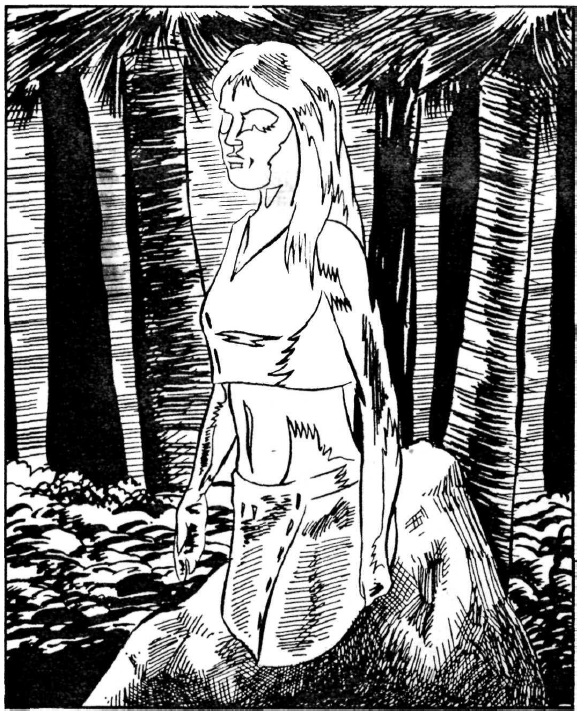 Man, I got way too drunk last night. Guys, what happened after I blacked out? Guys? Those poor Madlanders who don’t get a proper burial and don’t turn into monsters turn into undead. Madlands undead closely resemble revenants; they gain special powers related to the opposite of their virtues in life (wisdom turns into irrationality, kindness into sadism, their flaws magnified (gluttons can unhinge their jaws like a snake, blowhards turn into banshees) their personalities in general (drunkards autocast aura of intoxication, storytellers gain hypnosis powers), or just whatever they need to start loving people up. They also look the part, usually visually reflecting their deaths like a headless guy carrying his head Sleepy Hollow-style. Undead target people they were close to in life, try to kill friends or pursue desires left unfulfilled ”GURPS Fantasy II: Adventures in the Madlands” posted:The subject of an old unrequited crush might be targeted for abduction and a fate worse than death.  Ghosts also exist. They’re much rarer than undead (though they can be left behind by anyone), only showing up in certain circumstances. Sometimes, they straight up don’t realize they’re dead; sometimes, they have some emotional tie to the world they can’t dump on the way to the afterlife; sometimes someone just thinks of them too much, or because some idiot named their kid after them which allows the ghost to possess the infant. They have supernatural powers undead-style with a weird and probably unintentional twist; the book tells you to make ghosts by removing all their physical stats and skills and dumping their point value into powers, which means Ug the village idiot can move mountains and the village’s wisest elder can throw around a pot maybe. Ghosts are, well, insubstantial and can’t be harmed, but they can only show up under very specific circumstances like times of day or weather conditions. How do you make a ghost go away? Good question! 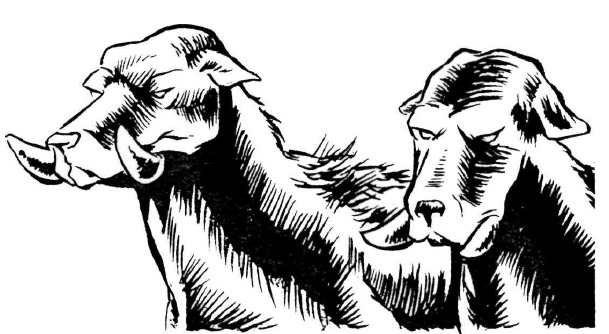 The pigdog, man’s worst enemy (except for everything else in the Madlands). poo poo That Isn’t Supernatural The grab-bag of the grab-bag. The end of the chapter includes a bestiary of the Madlands (imagine Fantasy Canada) with some unusual notes;
Incidentally. 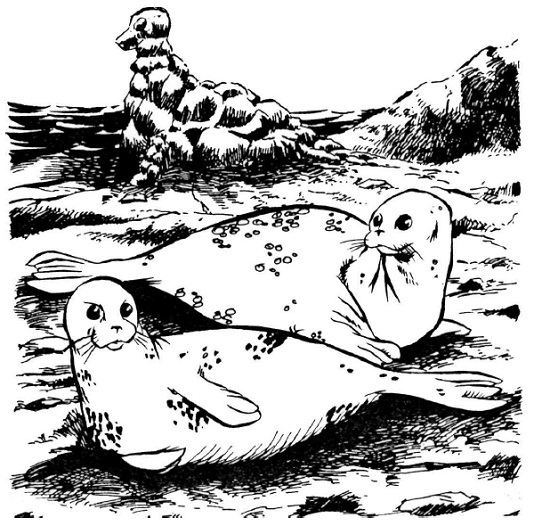 Honey, I know someone will buy your self-portrait, you just have to give it more time. Some seals in the Madlands are just ordinary seals (barely worth mentioning), but other seals are fully intelligent sapient beings; Madlanders consider them straight-up humans as far as crimes such as murder are concerned, an honor non-Madlander humans don’t receive. Seals like to eat (they eat the same things that Earth seals do) and bask after a good meal (they like laying around in the sun so much they’ll kill hostile interlopers with bites from a mouth filled with sharp teeth). Short of those two things, seals like to talk; they like to talk and tell stories and tell jokes and especially make verbal contracts and double especially combine those last two. Though a seal’s word can be always be trusted by a human, it has to be their exact word; they love finding and exploiting loopholes in such agreements and like to do so in such a way that it humiliates their opposite number. If you try to argue against one, it will just continue to argue until either side gives up, and seals can go a couple weeks without eating so good luck. Such arguments among seals can last for said weeks until hunger finally gets to the loser. Seals are individualists to their cores. They don’t oppose social relationships per se, but they rarely form permanent attachments; even mates only stay together during mating seasons, and seal cubs, creatures as intelligent as humans who need over a decade of socialization to function, only stay with their parents for two years. However, they have a powerful shared culture (presumably that’s how seal children are educated) that prizes humor, songs, and stories. According to the book, seals try to enter human contests in all of the above. They even create physical art (granted, stone sculptures of seals made by nosing rocks into piles). And part of this culture – a part they carefully conceal from Madlanders – is their use of Epic sorcery, a form of magic very different from the god-based shamanism familiar to Madlanders. Apparently nobody knows how the seals learned it and they sure aren’t telling. They can speak Soulless, though, so that’s probably how they got ahold of it. I’ll touch on the soulless at the end of the post. I like this chapter. Though some monsters are less inspired than others (coughheightlesscough) almost all of them can be a monster of the week or help form the basis of a story arc. The ordinary Madlands animals, though, are probably my favorite part, as quiet and unobtrusive as they are compared to homicidal organ-skeletons and raccoons that shoot laser beams and mind-reading feet. Nothing quite conveys how weird the Madlands are better than encountering a squirrel that suddenly looks like a person or hearing a porcupine give a drunken rendition of a folk song. It’s just so beautiful We’re almost at the end of the setting information. In page length. Not in post length. Oh, mercy, no. This next chapter has the exact same page count as the last but I’ll be lucky to get through it in three long-rear end posts, as it’s so dense with information that I, by my estimation, can cut down its word count maybe to a third without distorting the text, whereas I could reduce a half-page to a paragraph here. The next chapter deals with the Soulless, the only Madlands monster not covered in chapter Six. They are not proper Madlands monsters, though. They are elves. They are also dwarves. And they are the most terrifying example of either I’ve ever encountered. Next time: our elves are the worst elves Falconier111 fucked around with this message at 05:09 on Aug 14, 2016 |
|
|
|
Mors Rattus posted:How is the squirrel thing a survival mechanism? They get killed on principle...wouldn't being a normal squirrel and hiding be easier for that? It startles hunters. Even if you already know it happens, a squirrel suddenly looking like your dead Uncle Harry takes a second to recover from. FMguru posted:The same reason Eskimos live near the arctic circle, or Bedouins live in the sahara desert - all the other good land is taken and held by people stronger than them, and they've long adapted to living in that place. The second one, most of all. They stoutly believe everywhere else is worse and prefer the land of their ancestors. Simian_Prime posted:Madlands seems like the kind of setting that'd be perfect to adapt into a Lamentations of the Flame Princess module. I'm thinking an *world hack would do nicely.
|
|
|
|
wiegieman posted:Oh, I can't wait to hear what they think the other places have that's worse than giant feet monsters. I already touched on this, but to elaborate, Madlanders have no concept of history, analogize all deities and magic with the horrible forms they take in their homeland, and they're extremely isolated from the rest of the world. The few Madlanders to visit foreign lands either go to trade in freezing-cold and even more inhospitable Whiteness (no monsters, but Madlanders are used to monsters and the idea of being surrounded by divine snow terrifies them), or they're kidnapped by pirates and taken to Savarginia, a land so suffused in magic and stratified social classes that egalitarian and anti-magic Madlanders only come back traumatized. Just about every other region of the setting is a better place to live, but Madlanders have little knowledge of them and lack the cultural context to grasp even that. Josef bugman posted:GLORANTHA Yesss, thank you! Are you planning on (if you get there) covering the Hero Wars? I've never been able to get a picture of what they actually are; its mentions in the lore I've read are so vague I can't even tell if they don't have a structure so players can gently caress around in them.
|
|
|
|
GURPS FANTASY II 7 – THE SOULLESS, INTRODUCTION 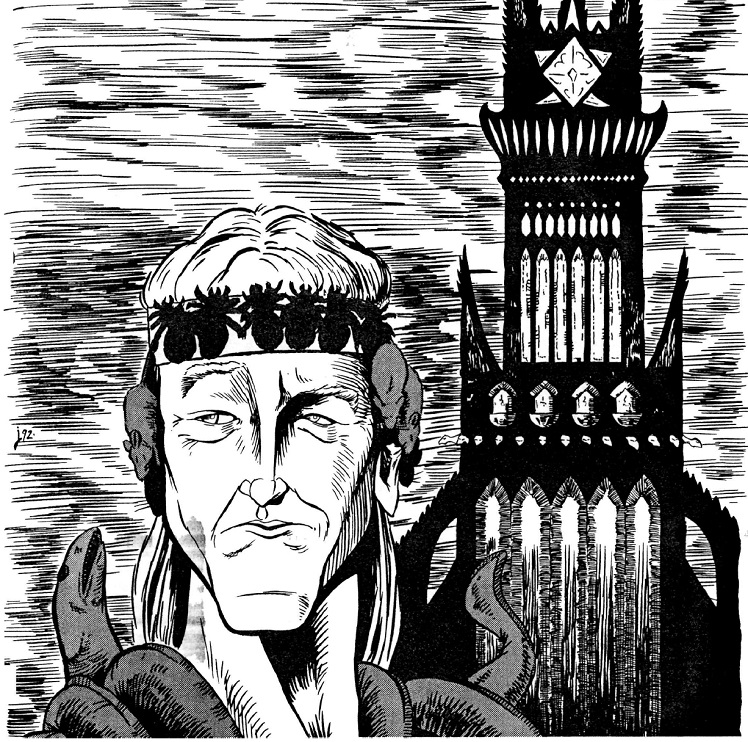 You ready to see what long-term immortality looks like? Too bad! ”GURPS Fantasy II: Adventures in the Mad Lands” posted:The final group of "monsters" native to the Madlands is the soulless. Unlike the others, they are a genuine race, with their own language and highly developed culture. Too highly developed, in fact. Cursed with immortality, the soulless are trapped in cultural stasis, having exhausted every means of diversion centuries ago. This has made them decadent and cruel. To the Madlanders, they're unpredictable, frighteningly powerful menaces. From their own standpoint, they're victims of a cosmic practical joke. To a Madlander, a Soulless looks kind of like a human. Their eyes are yellow and lack pupils; they have high, thin cheekbones, long, sharp noses, narrow heads, and narrow eyes; they’re usually a foot or so taller than an adult human male and maybe 20 pounds less; and their skin varies between any number of natural colors. They cannot die of old age, and so, with countless years of practice, they are so deadly in combat no Madlander can hope to outfight them and they’ve mastered magic even shamans don’t understand – however, they’ve also lost the ability to have children. They live in hidden ancient cities in the interior only accessible through seemingly-natural circles in the woods; rocks, trees, mushrooms and the like. Sound familiar?  However, unlike your standard fantasy elfs, Soulless are vicious sadists driven to a human definition of insanity by boredom. While they were once human(ish), tens of thousands of years ago they did some ill-defined thing that granted them immortality, but tens of thousands of years is a little long for a single culture to last; their culture exhausted any creativity it had roundabout at least 10,000 years ago, declined precipitously, and reached rock bottom 5,000 years ago. Soulless cannot die; though they can be killed, any time they die they reincarnate in the form of an unfortunate Madlander baby (which sharp-eyed elders usually bash to death on the rocks outside the village) and eventually gain back their memories. And since they’ve invented everything new they could think of, there is nothing more to discover or learn or live for and they are bored. The Soulless, whatever they might say, want nothing more than to die. Unfortunately, the magical pact that gave them eternal life prevents this. This leaves them a mite pissed off. With all my harping on about how Madlands can be used for campaigns with little adaptation, even Laws acknowledges that eventually players will get bored of village life and start to space out. The Soulless are his answer to that. While the Madlanders have achieved a culture that can last forever in exchange for comfort and security, the Soulless have phenomenal cosmic power and nothing to do with it. When you think the players are decelerating, start dropping hints that something’s coming (What kind of hints? I don’t know!) and let them plunge their asses into the Soulless Metal Cities. When they’ve finally emerged, their characters will have changed irrevocably and the campaign will end naturally. While I understand why something like this is included, as you’ll see, the Metal Cities are way too much for an ordinary character to survive, especially for anti-magic barbarians like the Madlanders. The Soulless are so wildly played up that it takes an insane amount of GM hand-holding just to get them through a session unharmed, and the separation of their two cultures is great enough that dead characters can’t easily be replaced. I can, however, see a campaign centered around a party of changelings who somehow miss the Soulless Patrol and grow up in the Madlands, only to eventually find their way to the Metal Cities and gradually regain their memories. But there’s no mechanical support for this and characters are left floundering whenever they get there. Naturally, there’s vanishingly little advice on how to GM Madlanders among the Soulless. Yay! There’s a LOT of ground to cover with the Soulless, and I neither like the way the book presents it nor think I should skip over anything. Have a hapless, meandering introduction!  A hostile nephrite trapezoidal prism. Once upon a time – and I mean a time, the Soulless can’t remember it because it was so long ago and their records are unreliable, but they think 14,500 or 22,700 years ago
So, you may have noticed there’s a little bit of haziness in the historical record, despite it being written down and all. Why? Mmmmmagic! 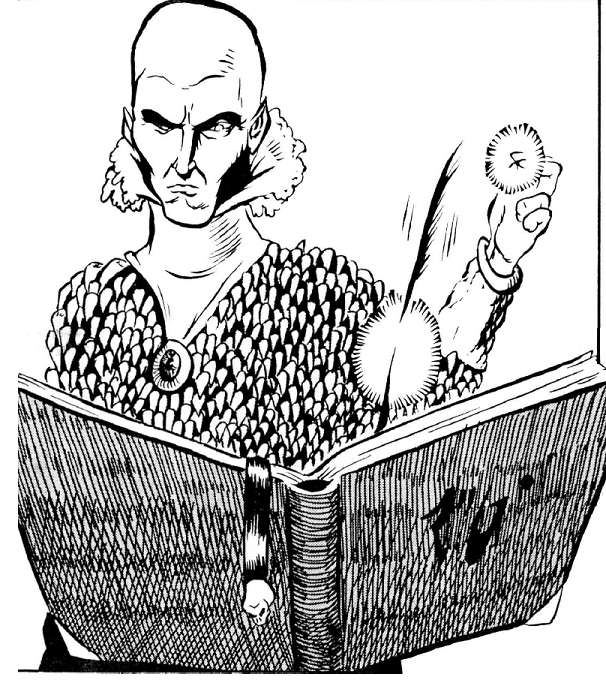 I gotta be honest with you, I forgot how to write. Every last aspect of Soulless culture boils down, in some way, to magic. Their magic isn’t shamanism; in fact, they despise the gods as only Randian individualists can. Instead they use four unique schools of spellcastin’: Epic sorcery, which uses the greatest achievement of Soulless literature to turn literary analysis into a superpower; gem injection sorcery, which is, well, gem-fueled heroin magic; singing sorcery, which, guess; and sacrifice magic, which they stole from the trapezoids (seriously, what the hell?) and categorizes sacrificed Madlanders as animals  . In fact, the Soulless consider sorcery the dividing line between intelligent beings and animals. Madlanders aren’t human to them (:elf:). This is a problem because, since they make literally everything in their cities through sorcery, their history books are made the same way; and because sorcery can and does reflect the biases of the caster, history has been so distorted that they’ve lost any trace of their original culture. And, of course, since everything’s made by magic, all Soulless have lost the ability to craft anything by hand or take pride in it. The only exception is the Epic, which Soulless value too much to risk corruption. It’s telling that, as much as they want to reclaim their past glories, they still rely on their centuries of magical experience to try and reclaim it. . In fact, the Soulless consider sorcery the dividing line between intelligent beings and animals. Madlanders aren’t human to them (:elf:). This is a problem because, since they make literally everything in their cities through sorcery, their history books are made the same way; and because sorcery can and does reflect the biases of the caster, history has been so distorted that they’ve lost any trace of their original culture. And, of course, since everything’s made by magic, all Soulless have lost the ability to craft anything by hand or take pride in it. The only exception is the Epic, which Soulless value too much to risk corruption. It’s telling that, as much as they want to reclaim their past glories, they still rely on their centuries of magical experience to try and reclaim it.There’s an undercurrent that runs through this chapter that never gets directly remarked on, but I think it’s wildly important. The Soulless themselves, though they believe themselves completely spent and creatively dead, are still intelligent beings with the ability to create new things. However, they are so submerged in their stagnant culture that they can’t. For instance, the Soulless, being radically individualist, regard any kind of divine being with loathing and disdain (and abject fear, though they’d never admit it). They consider any kind of divine being either an impostor or something actually below them, and they deal with the extradimensional beings they sometimes encounter as lesser creatures. The thing is, only such creatures are likely to finally kill them, but the Soulless can’t push past their cultural prejudices to consider it. Dying, or at least being changed into something new and interesting, is as easy as walking outside and thinking about Bett Agwo really hard – they’re so desperate for something new that they’re willing to do poo poo like going through drug withdrawal multiple times just for the sensation. They still can’t even consider it. I mean, apparently Soulless killed by gods come back as changelings instead of monsters, but you’d think they’d embrace divine alteration  . .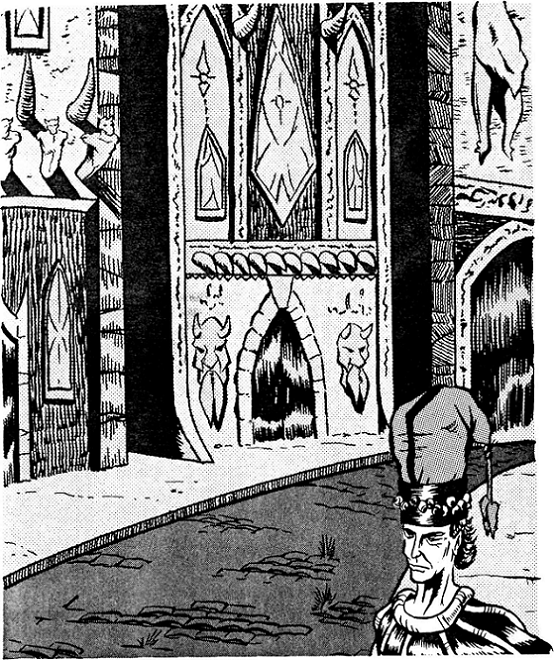 See? I told you they were dwarves! The Soulless actually deeply dislike the Madlands; divine contamination makes their spells go frequently awry and you can’t have that. Instead, they live in three “Metal Cities”, Kzowozymyzkz, Fyzkwyzkozpoza and Xymsdykyhjyzklz (SEE?) buried deep under the earth somewhere in the Madlands. You can only get to them through fairy-circle equivalents described above (:elf:), and once you enter you reach the Street, which, well, there’s only one Street in each city connecting roughly 5,000 inhabitants. Instead of it being, like, an actual street, the Street is a nebulous path between all the city’s buildings determined by the walkers. If you’re psyching yourself up for a duel to the not-death, the street is a narrow pathway surrounded by spikes with impaled people on them. If you just got magilaid, the Street is broad, the gem-plated birds are singing, and everything looks as pretty as it can, because it can’t by human standards. Soulless inclinations towards the overwhelming mean their buildings (which show up whenever the walker wants them to) are offensively gaudy and feature Doctor Who interior construction; this is another way Soulless show off, as they can set their houses to pop up as people stroll around or even force their buildings onto the streets. By the way, as Soulless are basically autonomous, there are vanishingly few public buildings, only excepting public entertainment centers. Finally, a note on Soulless language. Their language is so old and overdeveloped that even prepositions can last a dozen syllables and ordinary roots last several times that, not counting the dozens of modifiers used to communicate the slightest variations in meaning. The average Soulless word has 29 syllables  ! The book straight-up tells you, when it comes to pronunciation, to just fake it; the suggested method for coming up with Soulless words is to mash the keyboard for a couple seconds and edit the result to fit the spelling scheme. ! The book straight-up tells you, when it comes to pronunciation, to just fake it; the suggested method for coming up with Soulless words is to mash the keyboard for a couple seconds and edit the result to fit the spelling scheme. Dyfzhzygrizhnygok! Olzhdkygnogaopgynpagynropa! Afylgnoiufbyygagnalniuzhyygdlyal! In practical use, you shorten these to a few syllables or use a nickname instead. Next time: fashion means strapping live dogs to your ankles!
|
|
|
|
I'm so happy someone's covering Godbound. To me, at least, it feels like something like the culmination of OSR and storygame sensibilities; OSR mechanics and character building buttressing Fate-style traits and imaginative powers. Also, I'm happy that we get to talk about Words. Oh, goodness, the Words.
|
|
|
|
Neondystopia.com posted:ND: I think that’s one of the biggest problems with a lot of modern games, like the newest version of Dungeons and Dragons, is that it’s more concerned with the rules and the combat than it is with trying to tell a good story. The second major thing that I identified that Cyberpunk has contributed is the cyberpunk archetypes. We talk about Solos, or Street Samurai in Shadowrun, but really Shadowrun took their archetypes from Cyberpunk. This guy is my hero
|
|
|
|
Count Chocula posted:I feel like the whole 'immortality is a curse' thing is just something people tell themselves to feel better. People die, but art doesn't, and longlived vampires could be monks, contemplating art and feeding on the herd. Do YOU want to be an immortal monk isolated by mind and means from the rest of the world? People go crazy and even their health declines during prolonged social isolation, and the vampires who go through this were embraced less for their philosophical leanings and more for the sire's convenience/desire to hide a crime/political ambitions/misplaced parental urge/because they think their childe is really hot. Plus, if you'll excuse me citing a Daily Heil article (written by a real professor though!), your perception of time physically changes with age. WoD vampires have always struck me as way more human (mentally) than they'd like to admit (they'd have to be to be roleplayed), and an elder is what you get when a human lives forever in hiding and with magical powers. Christ I went through a lot of effort to cite my sources. Academia is a hell of a drug. Daeren posted:I met a traveller from an antique land Keats was a really good poet.
|
|
|
|
unseenlibrarian posted:...I'm not sure if you're misidentifying the poet or just throwing some shade at Percy "Bysshe Please" Shelley.  Shelley's actually my third favorite poet (Dickinson and Hughes take the top two spots). They're better than those modern poets who are too lazy to use a meter  e: corrected spelling for the fact that Shelley is a Romantic poet and not a member of Team Aqua. Falconier111 fucked around with this message at 04:35 on Dec 25, 2016 |
|
|
|
Quote is not edit.
|
|
|
|
Kellsterik posted:I really like that the Lancea just found Theban Sorcery and make a lot of unsourced claims about how it comes from the Christian God. This obscure Roman covenant of weird self-flagellating religious vampires has, by complete chance, achieved immense power and influence over the ages thanks to this magical secret they stumbled upon.  Also, I think that Kellsterik posted:This describes a lot of how vampire society evolves and functions. e: I just spotted that being a Malkavian is now a disease. Falconier111 fucked around with this message at 05:06 on Dec 26, 2016 |
|
|
|
GURPS FANTASY II 7.5 – THE SOULLESS, CONCLUSION Hey there, folks! Been a while, hasn’t it? …Nearly a year and a half? Christ. Anyway, if you want to catch up on what exactly the Madlands are, or just to bring anti-magic barbarians, organ-skeletons, and malevolent divinities that are also the cast of Winnie the Pooh into your life, go here. Right now, I’m just going to assume you either know where we left off (on sadist elves) or you’re going back to familiarize yourself. In the meantime, have a skull hat! 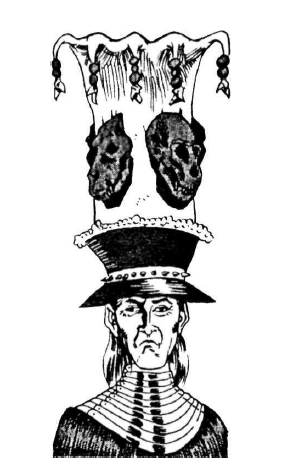 Fashion! Everywhere in the Metal Cities, the climate is a perfect room temperature, so there’s no need to wear clothes. The Soulless do so anyway, though, because it gives them something to do and it gives them a way to one-up each other. Modern Soulless attire makes no goddamn sense on purpose. There used to be coherent fashions but they’ve long since run through every possible combination (there’s an extensive sidebar that covers this progress in detail, but it’s not worth describing centuries of pantaloon development here) and just wear whatever they want. Because they are Soulless, “whatever they want” is usually weird. Rather than try and sum up Soulless fashion, and because nobody can stop me, I’m just going to quote this section in full: GURPS Fantasy II: Adventures in the Mad lands posted:One might see a woman with a four-foot hat in the shape of a whale, studded with diamonds and sequins. She wears a velvet top embroidered with gold threads in a pattern that continually shifts depending on the mood of the onlooker. From the waist down she's clad in flowing pantaloons with horizontal stripes in orange, purple, and yellow. Each stripe smells of a different fruit: tangerine, grape, and lemon. Her boots are made from magically transformed live pigdogs; with each step they howl in agony. Theater! The book doesn’t say much about Soulless theater, just that it’s popular and tends towards outrageous spectacle. However, in order to spice up the occasional death scene, a play might switch out a Soulless actor for a hapless human for the sake of verisimilitude. Sometimes they’ll actually spare a human who gives an exceptionally moving performance, though this is only so they can use them later for something even more dramatic. Plot hook! 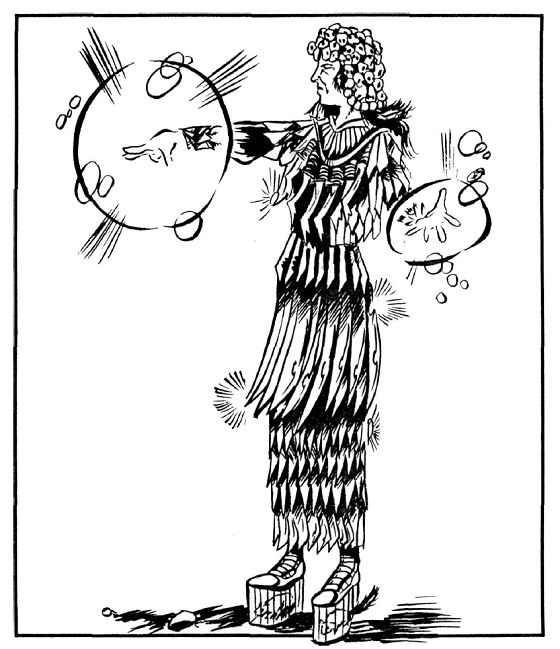 Going to war in dress clothing is the peak of sophistication. Soulless don’t die of natural causes; old age can’t kill them, which is part of the issue, but disease or deprivation don’t hurt them either. You can still come pretty close to killing one, though. Whatever else their bodies can do, they aren’t inherently tougher than a human; if you can get past their defenses (a tall feat) you can strike them down like anybody else. However, if you do pull it off, instead of dying, the Soulless’s, well, soul flies out into the Madlands and enters the next fetus someone conceives. That child is a changeling, and if the Madlanders figure it out, they’ll kill it on the spot. The book describes changelings as visibly different from ordinary human children, if easy to confuse with them; the book doesn’t make this explicit, but it’s probably those “minor anatomical differences” (i.e. they are elfos) coming to the fore. At first, changelings act like normal children, but when they enter Elf Puberty, their “fiercely individualistic nature” asserts itself and other Soulless start being able to track them down. At this point, they (apparently without exception) experience one of three fates: their friends come looking for them and start to gently caress up the village, only stopping when the changeling either agrees to go with them or a villager tries to negotiate with them by holding the changeling hostage (apparently this sometimes works, even after the Soulless have the kid and no reason to respect their promises); the same thing happens but it’s the kid’s enemies find them first, in which case they torture the changeling because So, at the beginning of last paragraph I mentioned how Soulless can die from violence, but haha good loving luck killing one. The fuckers had millennia to perfect combat and it shows. Without going into system details, a Soulless on hits almost every swing and dodges almost every attack, invariably possesses magical weapons and armor (as visually bizarre as the rest of their culture, though they do tend towards highly decorated traditional melee weapons instead of stranger poo poo), and can cast healing and stamina-restoring magic enough to stretch combat out indefinitely. Don’t fight Soulless. Any fights, duels, and brawls last until somebody at last fails a roll and takes some damage, usually admitting defeat. Sometimes, instead of settling their disputes like gentleelves on the battlefield, the Soulless will take each other to court, in which case they argue circles around each other forever, usually resulting in suits and counter-suits that can last for decades. There’s little in the way of a concrete Soulless legal system, just an endless maze of laws and counter-laws that Soulless use to gently caress with each other. Like everything else in Soulless society, it’s all a form of entertainment. 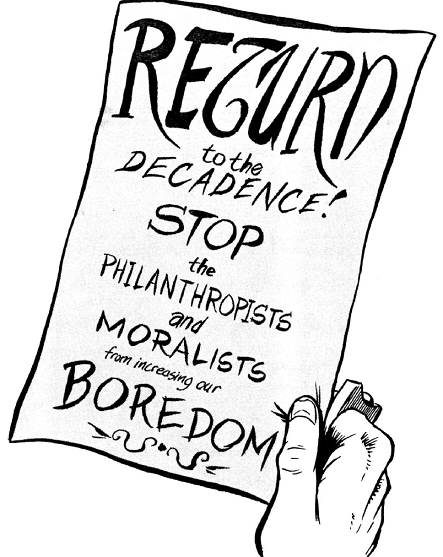 That isn’t Soulless writing! Oxlcyxowsyjys and the jyzuehyynkzd would be ashamed! After telling us in detail how unplayable the Soulless would be, the book gives us rules on how to play them  . All Soulless have extremely high stats, know every skill that isn’t setting-restricted to a degree beyond what’s normally achievable for character, know a shitton of spells in their chosen magic school (we’ll get to those schools next chapter), and generally just are shenanigans. Estimating from the given numbers, a Soulless character has maybe 550 character points worth of stats, advantages, etc., not counting skills, which if counted out would probably add a few hundred more. In the GURPS 4th Edition corebook, an average starting character has 100 points to spend. A Soulless has double that to spend on base stats alone. This is definitely not meant to be something players use, just a GM looking to represent the Soulless as anything other than GM fiat. Not that it matters, since they’ll outshine any PC anyway. . All Soulless have extremely high stats, know every skill that isn’t setting-restricted to a degree beyond what’s normally achievable for character, know a shitton of spells in their chosen magic school (we’ll get to those schools next chapter), and generally just are shenanigans. Estimating from the given numbers, a Soulless character has maybe 550 character points worth of stats, advantages, etc., not counting skills, which if counted out would probably add a few hundred more. In the GURPS 4th Edition corebook, an average starting character has 100 points to spend. A Soulless has double that to spend on base stats alone. This is definitely not meant to be something players use, just a GM looking to represent the Soulless as anything other than GM fiat. Not that it matters, since they’ll outshine any PC anyway.GMing Soulless advice! A sidebar on the last page of the chapter sets out three primary mental distinctions between the Soulless and Madlanders: they don’t see humans as “human,” more like talking chimpanzees, and could not give less of a poo poo about their opinions; they do anything they think might spark some emotion in them, meaning you can’t rely on them doing things that make sense; and they are all so goddamn old that the present feels like an eyeblink to them. This is why their language is so insanely 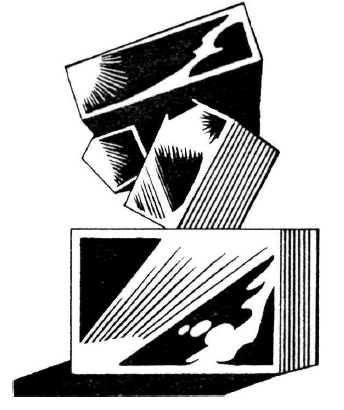 Have some unrelated art! The Soulless, in my opinion, are both the most interesting and most frustrating part of the book. These are some of the weirdest elves I’ve ever encountered, that’s for drat certain, and reading about them is a pleasure. But I can’t imagine a way to work Soulless into a campaign without mental backflips. They are so far beyond PCs that it’s difficult to even interact with them, their culture is already hard to understand without stacking it on top of another alien culture in the Madlands, and the mechanics associated with them (i.e. sorcery, which I’ll cover next chapter) are the pinnacle of extraneous design; there’s four unique magic systems, each with its own spell list and conditions, and all of them will not matter in any game since it would take PCs beyond their reasonable lifespan to even get started learning them. This chapter, is great as it is, is GM entertainment, like reading many Planescape sourcebooks. Who the hell ever goes to the Quasi-Elemental Plane of Dust? It’s still a fun read. Next time: Don’t inject crush diamonds into your veins, kids!
|
|
|
|
Joe Slowboat posted:What I'm getting from soulless fashion is that they have the same style sense as MMO players who have gotten extremely bored but can't bring themselves to stop playing. Which is pretty much the Soulless condition. Got it in one. Speaking of maxed-out classes! GURPS FANTASY II 8 – MAGIC  loving what why holy poo poo i thought this was a low fantasy setting Standard GURPS magic, like standard GURPS everything, is a strictly regimented system running off spells that function like separate skills, the caster’s stamina, and ambient mana. Madlands magic works off the same base system but uses two very different approaches – shamanism and sorcery, the first of which comes from the gods, the second from various Soulless magical schools. Since I just finished writing up the Soulless, I’ll do sorcery now, even if the book puts shamanism first. Keep that theme going. The book defines sorcery as any magic system that doesn’t rely on drawing power from the gods, but though it mentions other forms of magic, the only non-divine magic systems presented in the book are called Singing, Sacrificial, Epic, and Gem magic, and they all come from Soulless culture. All Soulless know one of these schools. You can learn more than one, but they require different mindsets and you have to switch between them; since being without magic in Soulless society is almost suicide, most don’t bother trying. Any Soulless can use just about every spell in their chosen school, but characters have to learn them individually; fortunately, every spell is symbolic with multiple, possibly overlapping uses, so even one spell can go a long way. Sorcery, at least in the Madlands, dates back a while, possibly to the prehistoric jyzuehyynkzd ( “GURPS Fantasy II: Adventures in the Mad Lands” posted:One reader became so passionately involved in his section of The Epic that he caused a rain of acid-spitting purple bats. Important note: sorcery doesn’t have set effects for each spell. It’s up to the caster (read: PC or GM) to decide exactly what the spell does. Instead, each spell functions as a skill that allows its user to invoke effects along some theme determined by the spell usually with the expenditure of a little stamina. 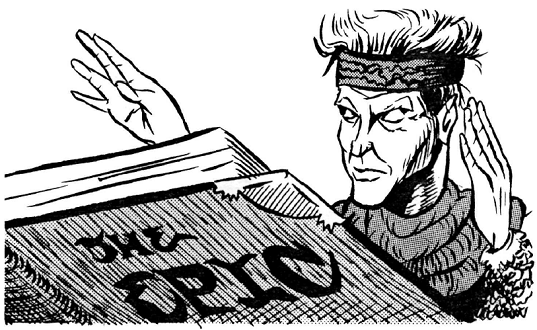 Pictured: not actually a spellbook. The Epic (always capitalized) is the highest work of Soulless literature, revered by almost every not-elf. Consisting of 14 volumes totaling 239 pages and telling the story of people with names like Dyjyfl, Vyblh, and Kydlyv, it’s the only work of art they actually copy by hand (though most of them memorized it thousands of years ago). It is in fact so revered that many Soulless can actually use it to cast spells. Incidentally, its writer, Yrrdisvibyf, wrote it over such a long period that the book compares the linguistic evolution over its course to that between Beowulf and TS Eliot, but never finished it; he looks down on Epic magic practitioners since he practices Singing sorcery and hides from fans/Epic mages looking for nonexistent insights into the text. loving hell, Soulless names. Epic sorcery casts spells by “understanding” some random line, chosen by the GM or some other means not directly involving the players (“The student can't choose which line he will suddenly understand”). You should pull these lines from any archaic poetry work that seems appropriate, though “GURPS Fantasy II: Adventures in the Mad Lands” posted:If the playing group contains any English majors, the works of well-known poets should be avoided. Unlike most other schools of sorcery, there is a place where you can actually learn Epic sorcery; the Critical Academy, an organization that moves cities every five years (one of the only times the book mentions how different cities interact) and theoretically practices literary criticism on the Epic. It’s been so long since anyone had a new insight that the Academy’s turned into a nest of academic infighting that would make any prestigious institution proud. However, if a character DOES go to the Critical Academy, the scholars will fall over themselves to teach them. Interestingly, the book mentions Academics stealing students from each other in the past, implying that outsiders have come by to learn sorcery before in enough numbers for patterns of treatment to emerge. 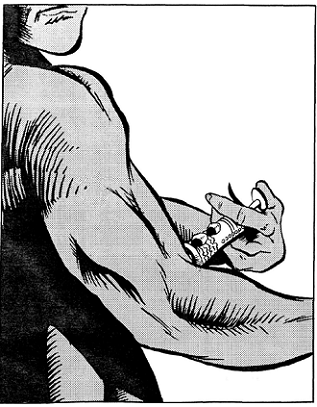 I wasn’t joking about heroin magic. Next up is Gem Injection sorcery, which, well, casts spells by injecting crushed gems. Into your veins. With goddamn syringes. Or, at least, they use the sensation of injection (an intense body high) as a focus. Each type of precious or semiprecious stone has a different effect when injected based on the metaphysical significance of that stone; garnets, say, control probability and pleasure, while quartz affects illusions and perception and turquoise is associated with rotting and dead poo poo. I’m nearly certain that’s what turquoise is associated with in real life. Gem injection is addictive and can’t be used to make more gems (diamonds can generate specific gems in a pinch, but they can’t make them economically). This means that, in a post-scarcity society, gem injectors are the only ones who need things they can’t make, which means they have to grovel in front of other sorcerers until they make them more gems, which, them being Soulless, means they’ll gently caress with them mercilessly before parceling out a fix. Why would people as obsessively individualistic as the Soulless subject themselves to others like that? Good question! Unlike lots of good questions in this book, this has an answer! While most types of sorcery are intellectual in nature, gem injection gives Soulless a reliable physical high even after all these years have dulled most sensations; plus, it doesn’t seem to affect a Soulless’s mental capacities, aside from gem reliance it’s just as potent as every other form of sorcery, and the body-wrenching sensations of breaking the addiction followed by the ecstasy of shooting up again is high entertainment. Also it uses the Chemistry skill as the Learning sorcery is a trial. Soulless, according to the book, see the ability to practice sorcery as the dividing line between people and animals, so a Madlander might gain some acceptance in Soulless society if they find a teacher. However, since no one’s taught a new sorcerer in ages (what about Epic magic students as mentioned above? Good question!), they've forgotten how to teach and will put students through endless trials. You can also learn through textbooks, but those that still exist are buried in trash heaps or used as door stoppers so good luck finding usable ones. The GM is advised to make seeking out a way to learn sorcery a part of the storyline so the PCs don’t spend their sessions floundering while failing to learn anything. 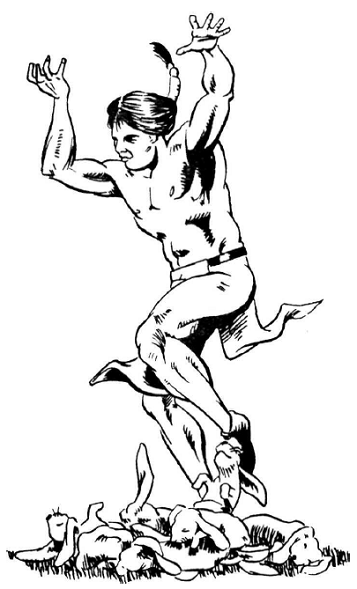 The missing link between shamanism and sorcery, probably. Next up is Sacrificial sorcery. The And yes, all of those are legitimate sacrifices. Different sacrifices have very different effects, many of which represent biases in Soulless culture. For instance, sacrificing cougars, which allow you control over animals, grants you the ability to command humans – if you can’t cast magic, Soulless don’t count you as a person. Human sacrifice does give you the power to manipulate emotions, so hooray for that “GURPS Fantasy II: Adventures in the Mad Lands” posted:since the resulting personality shifts dredge up abominable feelings like compassion, altruism and love. There’s an entire two sidebars on the mechanics of sacrificial victims here which I won’t cover because  haha gently caress you injectors Singing sorcery! Though it’s practitioners like to pretend it’s the oldest and most authentic magic style out there, they (probably, they’ve all forgotten the details by now) invented them by studying that trapezoid magic, working out the base principles, and grafting them on to their old  Rivalries! Being Soulless, all Soulless look down on other schools and consider their school the best possible type of magic. To sum up: Epic sorcerers consider themselves the most in touch with their Soulless nature, while the singers are dreadfully out of touch and sacrificers and injectors are just so gauche; injectors love how physical their magic is, and consider Epic mages simpering dilettantes, singers prudish snobs, sacrificers gross sadists, and all of them ungenerous assholes who just won’t give them any gems come on man I’m jonesing and my dealer doesn’t get back till next Tuesday come on I know you’re carrying; sacrificers think of themselves as brave individuals in touch with reality while other sorcerers hide behind books, drugs, or folk music; and singers identify with the foundation of their race, with the other schools either trying to replace ancient tradition with literary analysis, falling into emulating their former oppressors, or defiling magic by turning it into a physical thing instead of their perfect, cerebral, boring favorite school. This is like well over half the chapter. We still have shamanism and other, more distant magic systems to cover before hitting the GM advice section and sample village and finishing the book. Maybe two more posts. Next time: Christ, these powers are really on the nose
|
|
|
|
GURPS FANTASY II 8 – MAGIC, CONT. 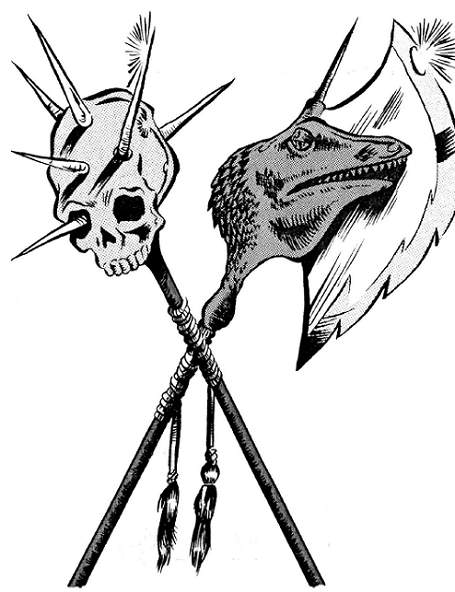 Shamans don’t gently caress around. Sorcery is a cerebral, refined art that relies on reason and cleverness to get results. Shamanism, on the other hand, is as unpredictable as the gods themselves. There are a couple of ways to get access to shamanic powers. The first and easiest/shittiest is by coming too close to a god and not dying; sometimes, this encounter will open a “mystic channel” to the god in question instead of just fantasy mental illness. The newly-created shaman has no way to dump this poo poo: they are stuck with it and just have to deal (i.e. go nuts). These folks usually end up with just one power. Others learn their magic from other shamans somehow, often forming a dysfunctional social network with each other; these folks are usually exiles or the overly curious, and they tend towards learning multiple spells. Either way, their powers come from propitiating the gods and carrying out their will in the world, in exchange for which they can blow people up and talk to thistles until their bodies give out. Except it doesn’t work that way. In reality, the gods couldn’t give two shits about their “followers” and probably aren’t even aware of them in the first place. Shamanism runs off the perception that the shaman is in one way contact with their chosen god/s. That perception lets them tap into the ambient magic that fills the Madlands (I mentioned in the last post how GURPS magic utilizes mana concentration in the area; the Madlands’ mana is powerful and really disorganized thanks to the gods). If the shaman realizes this, their powers stop working – sounds like a good way to dump your shamanic powers and go back to being an ordinary anti-magic barbarian. Unfortunately, according to the book, shamans very rarely realize this, which sucks for them. Too bad! Your life is over. 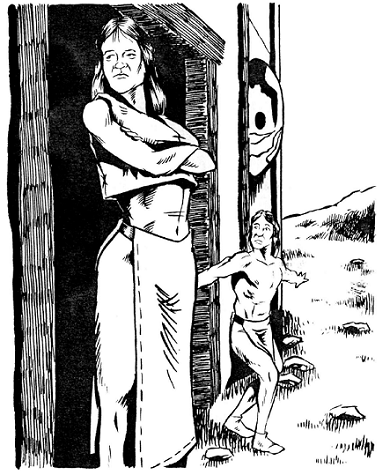 What the gently caress is going on in this pic? Is that an adult? Why do they look the same? Nobody likes shamans. Madlanders, naturally, know that shamans are inherently evil and gently caress them. The book even provides you with a list of standard ways that Madlanders look for if they suspect someone’s a shaman. In theory, it’s possible to play a shaman that isn’t an enormous rear end in a top hat, but a combination of prejudice and the inherent unpredictability of anything having to do with the gods makes that pretty tough. Shamans can sometimes hide in villages for a while, though, especially ones seeking power instead of being god-touched. These folks often form networks connecting shamans across multiple villages with more knowledgeable, likely previously exiled travelers. They tend to melt down and turn against each other, though, because, well, gently caress shamans. Cultural biases don’t stop applying even when you’ve found yourself caught up in them. The book provides rules for creating and playing shaman characters. It’s probably a bad idea. Shamanic powers, as far as I can tell, aren’t inherently corrupting or anything, but since being a shaman will get you kicked out of any community if you’re found out and shamanic powers fall victim to the same GM fuckery that Wish spells often do, shaman characters are usually boned. Either way, it’s expensive in character points to buy access to magic that might gently caress you over at any time. Don’t bother. 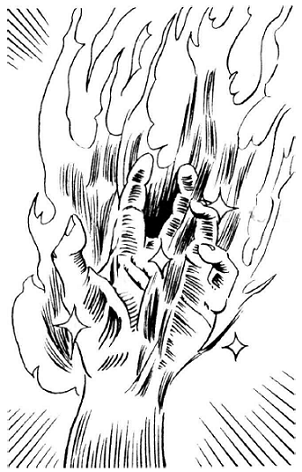 SHINING FINGAAAAAA Shamans get their spells at unpredictable levels of power, cost unpredictable amounts of stamina, and have unpredictable effects – license for the GM to gently caress with you, basically, whether characters are shamans or not. You know how the gods of the Madlands are Winnie the Pooh characters in disguise? And you know how I said shamanic powers are on the nose? GURPS Fantasy II: Adventures in the Mad Lands posted:Bounce ( 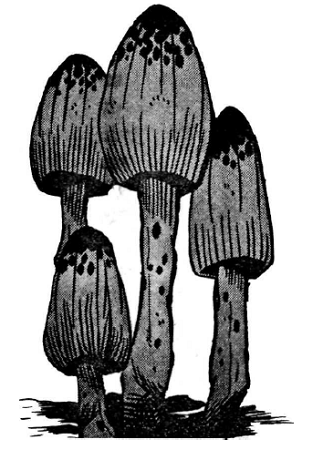 The last few pages of the chapter cover magic from other areas in scant detail, mostly how they relate to the Madlands. Apparently, the whole “magic works differently in the Madlands” thing applies to the rest of the world, too, just less so. The only magic in the Whiteness is sentient snow and it doesn’t leave the borders; the Northern Tribelanders, Mary Sues that they are, are shielded from harm by their GURPS Fantasy II: Adventures in the Mad Lands posted:“Cast Fireball At Municipal Guard On Council Day," for instance, or "Transform Pink Toad To 40% Silver Alloy." loving Madlands magic. There’s a lot of interesting stuff here, but it’s buried far away from where players can access it and overly complex even if they manage to reach it. Also, the book lets us know at the beginning of the chapter that Madlands magic is deliberately descriptive instead of concretely defined to emulate the fantastical, ineffable magic of many fantasy novels. I mean, it succeeds at that, but there’s a reason D&D defines those powers, and they aren’t as tightly designed as those in many storygames. You just end up with an unstable balance between player omnipotence and oppressive GM control that doesn’t accomplish much. Oh well. At least it’s an interesting read (that describes this book as a whole). Two more chapters, the GM advice section and a sample village, before the book is finished and I declare victory over this book. Next time: I finish the book, reveal what comes next, and finally get to drop a secret I’ve been keeping for nigh on two years.
|
|
|
|
GURPS FANTASY II 9-10 – CAMPAIGNS AND SAMPLE VILLAGE 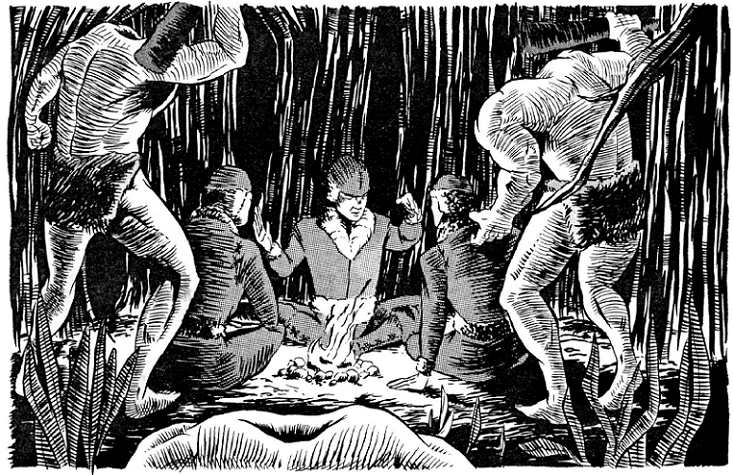 I love this picture so loving much. This post will be a little perfunctory – there’s not a lot of interesting meat here, other than character analysis in the village, and I’m unlikely to bother with plunging those depths. According to the book, Madlands campaigns should focus on characters and character drama rather than some kind of overarching plot. It takes kind of a storygame approach; have the players draw up their characters, give them some introduction to Madlander society (it recommends a festival of some kind), and let them do their own thing. From there, try to follow the hooks they took until a trend emerges. Maybe half a dozen plot hooks are thrown out in the chapter for play, most of them really only suitable for short arcs or just one session. As far as I can tell, you’re supposed to just chill out and take a hands-off approach to guiding them, which I guess works with such a small-scope setting. Moving the Madlands into Yrth! (That’s GURPS’s standard fantasy setting, someone covered it in this thread earlier) For the most part, this doesn’t matter unless you also own GURPS Fantasy I. If you DO want to insert the Madlands into another game world, though, you just have to hide it in some inhospitable corner of the world where no great empire will bother trying to take it over. If you choose to insert other cultures from the book somewhere else, though, you’ll have to account for Togeth (the other foreign lands are self-sustaining): it’s a young and outward looking society that’ll need something to model itself on. The book presents a few options from that setting. 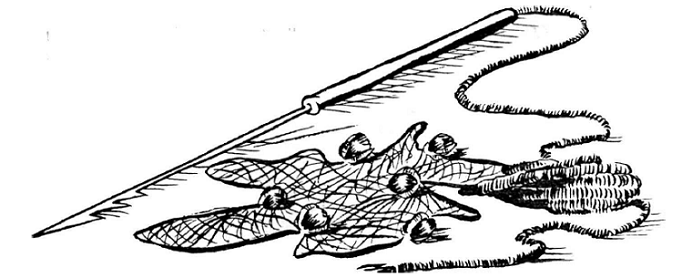 A Madlander anti-personnel rifle, probably. Madlander society is static enough that big efforts to change the status quo will likely either fail or just backfire (GM’s will notwithstanding, apparently). Still, if your players want to do something that isn’t driven by conformity, there are a few things you can do; you know, be reformers, try going somewhere less horrible, etc. However, you CAN try to take poo poo over, especially if you have access to magic. The Madlands being the Madlands, you’ll probably fail, at least initially, but if you flee into the interior, you can possibly forge yourselves a bandit kingdom from outcasts and skinless. The mechanics of the setting dictate that characters that do this will probably turn into skinless themselves, but that just makes it easier: skinless are loving badasses with extra strength, health, and supernatural bonuses. This is how you do evil campaigns. Other settings! One sidebar presents us with advice for crossovers into other settings/types of settings. Horror is easy (throw Madlands monsters into the present, let players follow them back to their home dimension), but the book suggests crossing over with cyberpunk, of all things; it seems to imply that the Soulless would set up a virtual reality that just happens to be some cyberpunk world. Okay, sure. Other options include superhero settings – use Soulless as a brake for rising demigods – and throwing a spec ops team into the Madlands and, as a book suggests… GURPS Fantasy II: Adventures in the Mad Lands posted:What begins as a walkover would slowly turn into The Lost Patrol. 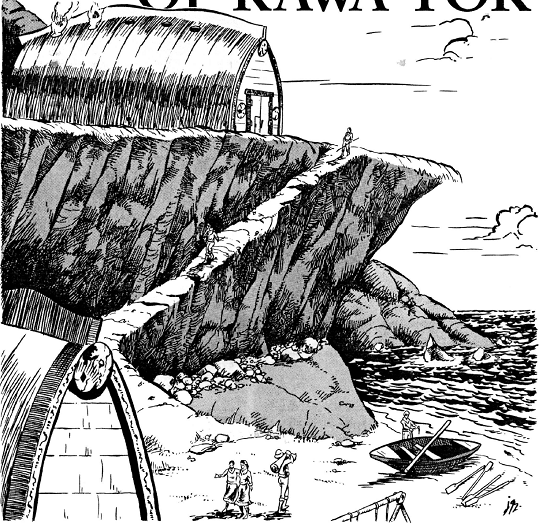 Man, all I can think of is a baboon holding up a lion cub. Since the village is the heart of Madlander life, instead of a sample campaign, the book presents a sample village to get you started. I’m not going to bother going in depth here, because it’s a collection of biographies and that’s it. Like, there’s two paragraphs of summary and then a dozen pages explaining the personalities and behavior of people like Buvazo Bako (the elder that’s everyone’s surrogate grandma) and Akik Takivodd (the village’s sweatiest hunter), most of whom have hilarious art alongside them, but that’s par for the course for this book. Then there’s a glossary, a map, an index, and we are done! I loving love this book, but the more I read it, the more convinced I become that it’s borderline impossible to run a campaign in it. I mean, if your group is invested in the setting, then you’ll have an amazing time, but it sure robs the mystery if you already know how everything works. Otherwise, you have too high a bar of entry for a campaign that’s mostly about hanging with your hunter bros instead of doing anything impressive or even all that exciting. This book came out in the 90s, but I wish it’d come out maybe 20 years later as a story game, maybe a PbtA hack or one of those limited-scope games that take up no less then a dozen pages and leaves the society for the players to develop. Which defeats the point of the book  . Either that or a series of novels – I could see them winning Hugos or something if written by the right person. But man, I really do want to gently caress around in this setting and fight megaelves and organ-skeletons and politic with villagers. Oh well. . Either that or a series of novels – I could see them winning Hugos or something if written by the right person. But man, I really do want to gently caress around in this setting and fight megaelves and organ-skeletons and politic with villagers. Oh well.This book is a real treat to read. I’ve covered the bulk of its content here, but there’s still a lot hiding in here that I didn’t cover for space purposes or giving people a reason to read it themselves. This book is so out-of-print that I’m surprised its PDF hasn’t deleted itself from my computer. If you can find it, give it a read. Hey Inklesspen? Are you still reading this thread? If so, do you remember my magnum opus? And what you said when I asked you included it in your archive for posterity? inklesspen posted:1: Done  
|
|
|
|
Freaking Crumbum posted:thank you so much for finishing this; I really enjoyed reading your review! Fantasy 2 is definitely the most bug-gently caress gonzo setting I've ever encountered that also had internally consistent logic and mechanics and wasn't just an obvious outlet for the author's sexual kinks. Yeah, this thing really shows the signs of being Robin D. Laws's setting baby that just happened to get picked up by a publisher (apparently that's actually what happened; I think Alien Rope Burn said something about that earlier on in the thread). Because it's Robin D. Laws, it escaped the traps most setting babies fall into. The most frustrating thing about the Madlands is that it's so dangerous RAW that outsiders will get gibbed without the support of the Madlanders, the Madlanders are xenophobic enough that said outsiders can't trust them for advice, and all magic they might use will go awry. It's just ludicrously hostile. For me, the best option would be using the standard GURPS 4th Edition setting, Infinite Worlds; the idea of that setting's technologically advanced, compulsively curious culture clashing against Madlander xenophobia and knowledge would be an interesting background for adventures. Or it would be, if it didn't come into existence years after this book  . Still, seeing if Madlands gods cans stand up to rocket launchers sounds like a great time . Still, seeing if Madlands gods cans stand up to rocket launchers sounds like a great time
|
|
|
|
inklesspen posted:You magnificent bastard! I found this book on Steve Jackson Games’s website literally days after you made that post and I’ve been keeping it under wraps ever since. GURPS Zombieland, USA PART 1 – BLACK LAKE I’m flying completely blind here. I’ve never read this book before, and I don’t know what I’m in for. I also have a (relatively minor) case of PTSD that this might set off! Probably not, though, from a light perusal it looks more than bearable. Ah well. I promised myself I’d do this years ago, so, here we go!  So, this is a weird one. For those unfamiliar, GURPS Autoduel is GURPS’s post-apocalyptic car battle setting; players drive their vehicles around trying to blow other vehicles up. Apparently, this book is written with both horror and exploding cars in mind. Thematic! The book is designed around the assumption that the GM will choose between running the scenario in the present day or in the far off future of 2038. This was published in 88, so, drat, we’re closer to the first date than the second. Author Barry Link, whoever that is (I can’t find anything about him on the Internet) wants to use this thing as a mixture of setting and adventure; the town has too much for one adventure to cover and can be revisited after the book’s core adventure has been exhausted. He also introduces an interesting concept; GMs are supposed to choose between characters that the book presents and use certain ones as “stars” that shape the narrative around them. Sounds a bit rickety, but I guess we’ll see.  Christ this book is full of maps The first chapter is entirely maps, location descriptions, and little biographies/character sheets in the sidebars, all describing the almost stereotypically small-town American Black Lake, California. Well, stereotypical in theory. The very first sidebar in the book lays out the three primary rules of a visitor’s social life in Black Lake: take things slow and steady, people are friendly to strangers but frown on bad behavior and snobbery, and any action outsiders take, positive or negative, will spread down the grapevine to the rest of the town and affect how people judge them. This is one of the few settings in which reaction roles are useful in GURPS; how people approach you, and how you react to them, will shape how your adventure plays out. Fourth rule, for Autoduel games only? Irritating outsiders won’t live to see the sunrise  Good Lord is that a lot of people to sift through. Yes, every one of those people has a little stat block squirreled away in the sidebars, and maybe a quarter of them have paragraph-long biographies to boot. No, that’s not a lot of information to sort through. Why do you ask? Black Lake is actually pretty comfortable, no matter which time period you visit it in. Most buildings detailed in the book exist intact in oth Autoduel and out of it, with the same people running them (just with the addition of lots of guns in the former). In lieu of writing out every single building description and biography I’ll cover a few of the most important/interesting people in the town. Wow, the  factor really starts out strong in this book! The very second person with a sidebar profile is one Mrs. Agatha Brown, an attractive (the book emphasizes this) middle-aged woman running a local boarding house who’s actually a “demented psi” who psychically enslaves the “troubled teenagers” who work there as maids. They are actually kidnapped teenagers she “gets secretly from area cycle gangs and rogues.” She doesn’t do anything with them; she’s just a sadistic rear end in a top hat who gets her jollies from making these girls miserable by stripping their agency away from them. Once she’s done breaking them, she sells them off to anyone who will pay. The townsfolk don’t know about this and think she’s a wonderful woman for working with all these troubled youth. Jesus Christ what the gently caress, Link! Yeah, she’s a pretty obvious villain for PCs to try to take down. I want to take her down. factor really starts out strong in this book! The very second person with a sidebar profile is one Mrs. Agatha Brown, an attractive (the book emphasizes this) middle-aged woman running a local boarding house who’s actually a “demented psi” who psychically enslaves the “troubled teenagers” who work there as maids. They are actually kidnapped teenagers she “gets secretly from area cycle gangs and rogues.” She doesn’t do anything with them; she’s just a sadistic rear end in a top hat who gets her jollies from making these girls miserable by stripping their agency away from them. Once she’s done breaking them, she sells them off to anyone who will pay. The townsfolk don’t know about this and think she’s a wonderful woman for working with all these troubled youth. Jesus Christ what the gently caress, Link! Yeah, she’s a pretty obvious villain for PCs to try to take down. I want to take her down.Next, Jerry Low, owner of the Pinetree Pub! He runs the town bar, a pretty quiet and civilized place – no brawls or roughhousing allowed. He’s an, and I quote, “Oriental” man who prides himself on his orderly establishment and also plays his tuba during happy hour. Badly. His stat block even includes “One badly-tuned tuba” under equipment and an atrociously low Musical Instrument (tuba) skill 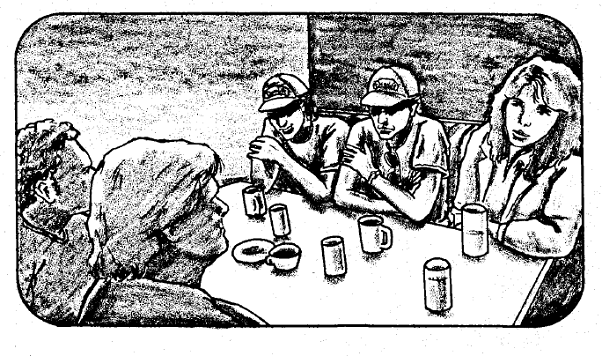 The truckers plot zombie murder. Ben McKinley, a cowardly, scimitar-owning (even though he can’t use it) Scotsman and hipster runs a little café literally called the Granola which serves East Asian, vegetarian, and horrifyingly enough, Scottish food. He has no major plot significance, but I couldn’t skip over him. Instead, Vic the Knife! He a greasy, cantankerous man who runs the Cave Bar, the local dive, as well as the local biker gang, the Shards. Thing is, well, he’s also an artist, in a “cynical, self-destructive outcast” sort of way. He’s a nationally published poet (albeit one who writes things like A Field Guide to Women’s Breasts) whose nickname comes from his sharp writing style. He even knows Latin well enough to speak it Fuzzy Dent is the town mayor, a rather amicable older fellow who has a habit of trying to mediate any argument he comes across; unfortunately, he’s also hard of hearing and frequently screws it up. At town meetings people just shout to make sure he hears them. He’s universally well-liked, visiting every business in town on the regular (including the Cave Bar, he thinks incognito), greets people on the street, and owns Black Lake’s general store – he manages to walk the fine line between running the town’s biggest store with pay and bonuses for his staff and not driving any of the specialist stores out of business. An all-around nice guy. Among those specialist stores is the flower shop run by Simpson Godot, the town’s most famous resident, an artist who does something with videos. The book straight up hints it might be hentai, which, okay. A few unremarkable food shops until we hit  He’s a Polish immigrant with some kind of abusive relationship with his wife (one probably beats the other). Still, his pastries are popular all over town so he sees a lot of business. In Autoduel, he’s one of the vanishingly few people who knows how to get real wheat instead of post-apocalyptic algae, so he’s both one of the world’s few bakers and vigorously watched by the FBI. What’s this about that whole Zombie Father thing? Nothing in the text in this part of the book hints at it! Stop slandering this poor man! Next time: more people!
|
|
|
|
Zereth posted:If that was their goal they should have just gone "nope, dreamlands aren't a thing" rather than "The dreamlands got eaten and if you try to go there or use basically any spell related to them, your soul is eaten and you die instantly". The latter just feels spiteful. There's very little in CthulhuTech that isn't spiteful. The only question is who or what they're spiting.
|
|
|
|
GURPS Zombieland, USA PART 2 – BLACK LAKE, CONT 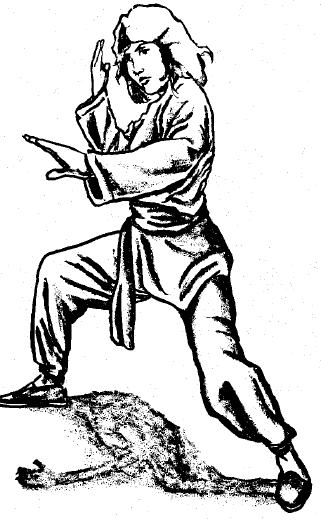 THE FACE OF TERRISM Deputy Amber Lane is a police officer who also runs the Zen House, a local East Asian-styled religious commune that accepts anyone willing to work in the gardens and maintain the building. Lane doesn’t run it for profit; it’s a labor of love for her, combining her contempt for modern society with a desire to teach her particular version of Zen Buddhism and martial arts. This lady, from her description, sounds white as hell, but she actually has East Asian constituents some academic knowledge of Zen, even if it’s kinda low, so  . She makes up for budget shortcomings with donations. She’s also secretly a radical anarchist who hides terrorists on the lam and the FBI is after her in both settings. There are two other religious institutions in town; the Church of Pure Values, your standard evangelical, “family values” church, and the Black Lake Free Church, a socially progressive church (in Autoduel, part of a broader network of similar churches). . She makes up for budget shortcomings with donations. She’s also secretly a radical anarchist who hides terrorists on the lam and the FBI is after her in both settings. There are two other religious institutions in town; the Church of Pure Values, your standard evangelical, “family values” church, and the Black Lake Free Church, a socially progressive church (in Autoduel, part of a broader network of similar churches).Jesus Ortega is the town mechanic and an unparalleled engineering genius. He’s also blind. Like many blind people, he can mostly function on his own, only needing the assistance of his daughter Maria (a mechanic in her own right considering going into physics) and Uncle (some guy) when working with unfamiliar parts; either way, his reputation is such that the local say “Jesus saves” to anyone with malfunctioning automobiles. He’s also a passionate socialist who gives substantial discounts to foreigners to kindle brotherhood between nations. In Autoduel, he extends the same mechanical ability to maintaining and installing weapons. Barbara Fram runs the local paper and is kind of an rear end, notable for trying to shout down interviewees and facing multiple libel lawsuits. Her paper is almost entirely local news and fluff pieces. She also employs Sydney Jonathan, a rich boy sent into rural exile by his father for misbehaving at Oxford. He loving hates laid-back, friendly, isolated Black Lake and would leave if he thought it wouldn’t get him taken out of his daddy’s will; he’s taken to working at both the paper and the local radio station, and easy listening station that doesn’t seem to make as much as it costs to run, to make up for the gambling debts he’s accrued trying to stay sane. In Autoduel, he’s actually a very capable fighter, as good as anyone else in town, but he shuns these hicks and won’t join the militia.  Eeeeeeeheheheheheheheee Dr. Malcolm Fraser, the town dentist, isn’t terribly notable. He just has a high History (medieval torture methods) skill Glory Muldoon is the Sheriff and (in Autoduel) leader of the town militia. She’s kind of a weird inversion of a stereotypical male ex-soldier; she has a military background, all sorts of military and policing skills, and she openly looks down on men while enjoying seeing male strippers. Despite this she’s universally respected by the townsfolk and runs a tight police department/militia. She doesn’t have any secrets beyond that. Her local opposite is Doc Willy Basset, the only doctor in town. He’s an expert physician, committed pacifist, and opponent of Sheriff Muldoon, someone he calls “the Soldier Bag”. He does have a secret; he has Magic Resistance, it runs in his family apparently. He doesn’t know why. Wiley Kiley! He’s the ex-Army Col. who effectively runs the local retirement home. Kylie’s an old Patton-obsessed warhorse who spends his time organizing social events and doing whatever it is that old people do when no one’s watching. In non-Autoduel games, just like in real life, you want to tread lightly around the elderly retirees or they’ll ruin your life in the community. In Autoduel games? Kiley and his cohort play their part in defending their town by manning A loving ARTILLERY BATTERY  Tourism dollars well spent! Geography and town history! Black Lake started life as a mining town during the Gold Rush and then the rush folded. The inhabitants switched to logging, then to tourism as time went on. The old mine is still around, but it’s been abandoned and gradually crumbling since – until the hilariously euphemistic ResourceCo snapped up the land, promised the locals they’d reopen the mine and provide them with jobs, and imported workers instead that never spend their pay in Black Lake or pass through it or even leave the mine. Boy, I wonder what they could be? There’s also the Black Lake itself, a hospitable mountain lake notable for being both unusually warm and unusually deep. The bulk of the lake is open to the public, and though the locals play up the  factor for tourists it’s perfectly safe… (Ellipsis from the book) The only part of the lakefront closed to the outside world is a mansion owned by a Midwestern medical firm called Columbus Meditech. The property is patrolled by armed guards and walled off from the outside world. factor for tourists it’s perfectly safe… (Ellipsis from the book) The only part of the lakefront closed to the outside world is a mansion owned by a Midwestern medical firm called Columbus Meditech. The property is patrolled by armed guards and walled off from the outside world.I wonder where the zombies come from? Next time: Autoduel rules (pun probably not intentional) Falconier111 fucked around with this message at 06:24 on Dec 21, 2017 |
|
|
|
Foglet posted:♫ Do you hear the blobbies sing
|
|
|
|
GURPS Zombieland, USA PART 3 – TOWN DEFENSE  Man, this town is weirdly square in BOTH settings. In Autoduel, the worst parts of the biker-gang-pocalypse are long over, but there are still bandits, cycle gangs, and other assorted ne’er-do-wells roaming the nation and every town needs some kind of defense plan. The Town Council of Black Lake dedicates a full 4/5 of its budget to that task, primarily using it to outfit the Lakers, the town militia. A few pages of this chapter are dedicated to physical defenses of various kinds which I’ll largely skip. However! You know how I said the seniors had an artillery battery? Turns out I lied, it’s just a tank gun-equivalent made from spare parts mounted in the senior center’s tower. Still, they’ve got the land around town plotted out, have a spotter’s nest secretly positioned somewhere in the nearby mountains, and enough ammunition, operators, and training to greet unwelcome visitors with a tank shell to the teeth. Other than that it’s a mix of two drawbridges, a big ol’ ditch, and some gun emplacements. The Lakers are actually pretty well organized, coordinated through the Sheriff’s office and divided into several squads. Hilariously, their backbone is three dozen arthritic old people, Kiley’s Senior Citizens’ Heavy Weapons Club. About 10 of them are on duty at any given time – the rest are sleeping, relaxing, or sick – and they man both the tank gun and a couple recoilless rifle positions. Then comes the foot soldiers: the scouts, who patrol the surroundings, gather information, and carry out raids on raiders; three infantry squads, one managing each drawbridge and another (associated with the Church of Purity) kept in reserve; a medical team run by the town doctor; and the irregulars, i.e. anyone capable of pointing a gun out their windows at intruders. Also there’s the AADA, the club that all the town’s Autoduelists belong to. Despite the name, these folks mostly avoid dueling in favor of target practice and nonlethal matches. The club’s membership is entirely NPCs described in sidebars, including my man the town dentist.  Next is a bunch of details on militia organization and planning I’ll cover if they come up in the adventure. Most important thing here is procedures for visitors; they enter through the southern drawbridge, get grilled by Sheriff Muldoon, and either enter without further harassment or get kicked out. Preparedness! Link emphasizes both the militia’s solid training and its inexperience. The only time they’ve had to face action was years ago: a bike gang slipped past Black Lake’s warning system but stumbled into the town defenses, the militia recovered from their surprise first and annihilated them. Since then they’ve never had to face anything worse then small raids on nearby farmsteads and the occasional rowdy visitor.  WARNING: THE REST OF THIS REVIEW WILL CONSIST OF SPOILERS! I’M NOT GOING TO BOTHER CENSORING A 30-YEAR-OLD ADVENTURE SO DON’T READ ANY FUTURE POSTS IF YOU CARE! WARNING: THE REST OF THIS REVIEW WILL CONSIST OF SPOILERS! I’M NOT GOING TO BOTHER CENSORING A 30-YEAR-OLD ADVENTURE SO DON’T READ ANY FUTURE POSTS IF YOU CARE!  Zombie rules! A couple paragraphs of description on how Autoduel Americans might respond differently to zombies. Since I haven’t read the adventure yet, I’m not entirely sure how to interpret them thanks to their copious references to plot points. Still, three points emerge: violence is more common and accepted in general; second, the plot emphasizes using more subtle means than blowing poo poo up with mounted weapons to solve the scenario’s problems; and the adventure’s villain is some guy named Nash and his dastardly plot has something to do with clones. Organization! A short section today; the whole chapter is like five pages long. Congratulations! We’re almost halfway through the book! Next time: the actual adventure!
|
|
|
|
Whoops! I missed a whole page last chapter. Good luck it didn’t contain anything important! GURPS Zombieland, USA PART 4 – ENTERING TOWN Let’s start the adventure! One of the PCs receives a letter from Mayor Dent of Black Lake asking for assistance (without naming what for) and offering them a check for 500 bucks if they show up. If they choose to accept, regardless of which setting you are using, the trip is pleasant and uneventful. If they don’t, the book advises you to consult a sidebar titled “Bending the PCs to Your Will”. Despite the name, it suggests relatively gentle methods like adding various hooks or, at worst, subjecting the PCs to minor engine trouble that directs them towards the town instead of punishing players for misbehaving, but never getting your players on board with the scenario before hand in any way. Eh. In Autoduel , things are mostly the same with one addition:  Once they arrive, after getting grilled and warned by the deputy on-duty, the PCs can enter the town and wander around greeting whatever NPCs the GM desires; they all extend a warm welcome while directing them to the town hall. After dealing with his secretary (who tries to chat them up for information out of pure nosy curiosity and will burst into tears if the PCs are big enough dicks) Fuzzy Dent himself welcomes them into his office. After passing a bickering Muldoon and Bassett on their way into the office, Dent tells the PCs he never sent a message or check and has no idea who they are. He’s genuinely confused – even extra-normal powers confirm this – but if they think to have them check his ledgers it looks like he actually did send them something. In the meantime he invites the party to stay at his motel. Did I mention he owns the only motel in town as well as the general store? Nope! Conflicts of interest! On the way he introduces them to yet more townsfolk including Deputy Pasha Lee. Something else I missed! Pasha Lee is the adventure’s designated love interest. An Asian (again the book uses “Oriental”) woman with the Appearance (Beautiful) advantage, she’s almost sickeningly clearly designed to attract a PC’s romantic attention, from the love of animals to the mechanically-represented friendliness to the GM advice (mostly the circumstances in which she’ll fall in love with a PC). The only thing saving her from being completely awful is a love of sport shooting and the bonkers weapons skills to back it up, but still Anyway. Once they reach the motel, Dent invites them to make themselves at home and departs. The book again emphasizes that the townsfolk are both friendly and a little suspicious of strangers. The first signs of trouble emerge here: any attempts to contact the outside world run into technical difficulties that the operator (it was a different time) promises to fix. The motel has two other groups staying. The first is a bunch of fishermen complaining how they can’t fish in Black Lake because a storm drowned three locals in the lake (who? Good question!) And they value sport fishing over their lives. The next morning they leave to go hang out in another adventure. Obvious info dump! The other group is actually plot relevant. Led by a new hotshot reporter named Marjorie Goldblum, they were sent here by a media company called DocuLife and they are here to film a documentary about small-town American life; the crew consists of Marjorie, her sound editor Tony Brummet, cameraman Cliff Sanger, and precocious daughter Julie. They filmed the funeral of the three locals, all sons of the baker Homencik; they can also describe the mine situation to the PCs. That night PCs with danger sense-type abilities see a black van they haven’t seen before go down the road outside their windows.  Wait, four? Plot time! The next morning, the three brothers’ graves are empty! The sheriff, Mayor, and documentary crew are on the scene. Blah blah dug up from the inside blah blah blah footprints from shoeless feet blah blah no signs of tools blah blah the grave keeper says he heard banging and horrible moans last night blah you get the idea, they’re probably zombies. If you suggest that to anyone they horselaugh you, as they should, but instead of coming up with a legitimate suspect Muldoon just goes and arrests Vic the Knife because she doesn’t like his face (he’s innocent (if still a dick); if the PCs can prove that, she’ll grudgingly let him go, and if they do it in a way that (somehow) impresses her she’ll respect them and help them out in the future). Whatever happens at the graveyard, the police eventually haul the PCs through a crowd of enraged townsfolk to read them a statement about the incident, I guess, when suddenly! One of the deputies bursts in with news that there’s trouble at ol’ Captain Fred’s farm! The police rollout tailed by the documentary crew, Sydney Johnson (looking for a scoop), and probably the PCs. Next time: human flesh tastes like chicken
|
|
|
|
GURPS Zombieland, USA PART 4 – SUPER ZOMBIE BROS. Fred’s farm! When the posse arrives, they meet Captain Fred, a local farmer still clutching his shotgun. Inconsequential back story! Fred might actually be a spaceship captain lost in time. He certainly has skills relevant to piloting spaceships but inappropriate to the setting. Or he might just be delusional, the sort of person who believes in ancient aliens or whatever without letting it affect his life. GM’s choice. Apparently last night he walked out to investigate who was messing with his chicken coops when he found the Homenciks eating his chickens raw. Salmonella!  You guys have no idea how many maps I’m skipping over. By the way, the GURPS equivalent of a SAN check is a Fright Check; I won’t go into mechanical details here because eh. Every time something even vaguely unnerving happens in this adventure, the book has you roll a Fright Check like a scare chord's playing in the background. I think it serves the dual purpose of scaring the characters and making emotional beats clearer to the players, but it is a little clumsily delivered. Anyway, Fred managed to scare them away with a few gunshots, but he noticed two things: first, the brothers were extremely pale and he couldn’t see their irises; second, he actually shot one, but he got up after he fell and just kept going. Yada yada a bunch of chances for the PCs to prove it was the brothers and also they were probably zombies. This is the first time anyone actually considers the possibility of zombies, though they won’t believe it for a while. Now the PCs are let loose on the town to search for clues. Naturally Muldoon will be doing so as well, but if the party’s obtrusive and annoys the townsfolk (but not necessarily her), they’ll be run out of town on a rail (or at gunpoint in Autoduel). Though the Sheriff will deny the “Zombie Thesis”, if they are deferential and don’t interfere with the official investigation she’ll eventually warm up to them (even the men). Deputy Lee, a.k.a. the designated love interest, will be more amenable to working with the PCs in general. Link goes out of his way here to make the point that the Black Lake Police Department aren’t your standard idiot authority figures in a horror story; they legitimately want to catch the villain, whoever or whatever it is, and they are taking substantial steps in doing so, but they aren’t willing to turn to supernatural explanations yet. The PCs’ first obvious step is checking in with Fred; he says he has a feeling the boys will be back (he’s right). At the scene of the crime there’s a trail of footprints leading into the forest (did the Sheriff follow them? Who knows!) and the PCs can follow them/get lost in the forest. Either way, after a couple hours the party stumbles across a cave that looks like it might be some kind of zombie den. They are wrong, there’s a black bear living in. No matter what they do, the bear gives them a chance to  I was going to make a Thriller joke, but man, every woman in this book has a bad case of 80s hair. If they decide to stake out the farm instead, the brothers show up! In the modern day, they are bog standard zombies who just eat their way through anything alive they can find. They are still pretty dangerous and need to be dismembered to be stopped, but a party with combat experience will make it out just fine. In Autoduel things are a bit tougher. The brothers have higher stats, more combat abilities, and are wearing Kevlar vests (  ). They are no match for any armed vehicle to take out, but the book advises the GM to prevent cars from coming into play through whatever excuse they can think of. In either setting, the fight goes on (with Fred pitching in if the going gets rough, possibly with a laser pistol) until the zombies are all dead or Sheriff Muldoon arrives with extra firepower and quickly ends the fight. She’ll detain the party until she figures out she has no idea what questions to ask them and tells them to show up at a town hall meeting the next morning. As they head back to the motel the documentary crew shows up, digs for information, and films the scene of the crime. ). They are no match for any armed vehicle to take out, but the book advises the GM to prevent cars from coming into play through whatever excuse they can think of. In either setting, the fight goes on (with Fred pitching in if the going gets rough, possibly with a laser pistol) until the zombies are all dead or Sheriff Muldoon arrives with extra firepower and quickly ends the fight. She’ll detain the party until she figures out she has no idea what questions to ask them and tells them to show up at a town hall meeting the next morning. As they head back to the motel the documentary crew shows up, digs for information, and films the scene of the crime.If the party chooses not to stick around the farm that night, they find out the next morning that the three zombies ate Fred alive before the Sheriff and co. showed up and killed them. Great job following up on leads!   dude this is totally going on Instagram The next morning the party runs into a crowd on the way to the meeting; they are all staring at something on the street. Someone wrote “SLAY THE BEAST” in the middle of the street with blood. Reassuring! After elbowing past the crowd the party arrives at the city council meeting, basically a town hall, where Doc Basset presents his autopsy (they are zombies, though he doesn’t say it), the town leaders split into a “throw them in prison” and a “when are we going to address the potholes on Main” faction, and Muldoon sides with the former and resolves to arrest them. Before throwing them into prison, the Sheriff allows the party one chance to talk their way free. If they succeed, they go free; if they fail, they get thrown in prison next to Vic the Knife (if they didn’t free him earlier) and given their traditional phone call (any calls outside of town hit a busy signal). Either way, they suffer a fate almost worse for an adventuring party then imprisonment: They have their weapons confiscated. Next time: evangelicalism gone wild
|
|
|
|
JackMann posted:Just caught up on the thread. If this was in the shamanism section, isn't it probably someone using the shrink power? Definitely, its just that the anatomy in the picture is bizarre. Speaking of which! GURPS Zombieland, USA PART 6 –  From behind a sign in the street to behind the pulpit. More people I missed! The Rev. Jim Fisher leads the Church of Pure Values and fills the role of wacky southern-style preacher right down to the copious Amens. He’s been convinced for a while that the End of Days is near, and guess what? It looks like he’s right! Except he isn’t, his stat block unambiguously says he’s delusional. Still, he has a sizable following in the town and in Autoduel he leads the Lakers’ crack infantry squad. The first time the PCs will see him is holding up his obligatory “The End Is Near” sign at the Council meeting. Whatever happened to the PCs in the last section, Link wants them railroaded towards hearing Fisher’s next sermon, whether they hear it over the radio in prison or attend the sermon itself. He’s wrapped a few important points up in his rhetoric: zombies mean the apocalypse is near; the Beast is the devil; you have to slay him by being part of the Army of the Lord. I’ll say it again here; I’m writing these updates as I read them, so I don’t know how much of the sermon will be relevant later or what, I’m just guessing. No, I’m not going to spend 20 minutes reading through the rest of the adventure. What, are you expecting me to put effort into this? So some weird poo poo starts to happen. If the party’s still in jail they see Vic get dragged out, hear a gunshot, and meet a returning Vic who doesn’t remember them. If the characters are sharp enough, they catch a glimpse of that same black van from earlier driving by. Scare chord! Somebody seems to broken out the Men in Black memory wiper thing. Pasha Lee, if a PC has somehow already gotten her attention, will be invited out to a picnic before completely forgetting about them later that day; the party witnesses a small child running away from their mother screaming “she’s not my mommy"  before the mother sweeps them away. Hell, even Sheriff Muldoon will let them out of their cells/seek them out in the town and ask for help; apparently other members of the police department attacked her and she’s willing to trust the PCs as they seem to be on the level. If she leaves their presence for more than half an hour, she also forgets. Any rational person’s first instinct would probably be to get out of town, but if the PCs make the sensible and boring decision to leave town they’ll have two fight through posses of various groups in the town. They try to discourage leaving the town, only using lethal force if the party tries to push through, but, why would you try to leave the adventure like that? before the mother sweeps them away. Hell, even Sheriff Muldoon will let them out of their cells/seek them out in the town and ask for help; apparently other members of the police department attacked her and she’s willing to trust the PCs as they seem to be on the level. If she leaves their presence for more than half an hour, she also forgets. Any rational person’s first instinct would probably be to get out of town, but if the PCs make the sensible and boring decision to leave town they’ll have two fight through posses of various groups in the town. They try to discourage leaving the town, only using lethal force if the party tries to push through, but, why would you try to leave the adventure like that? And you thought you hated closed MRIs! Eventually their investigations will lead the party to Doc Basset, who bought this newfangled medical machine from one Dr. Bob Smith of American Medical Technologies (a company that doesn’t seem to exist). The machine is extremely advanced; it’s some kind of full-body scanner that produces crazy accurate medical information but just looks odd to any characters with medical training. PCs can have themselves scanned if they are dumb. Any attempts to examine the machine more closely will be rebuffed. If the PCs try to break in to Basset’s office to get a closer look or stake it out, provided they don’t do it in broad daylight, they see Basset working with some shady types to load black boxes onto a van. If they spot the party, these folks will train their guns on them; if they back off, they’ll let them go. If not, the stranger opens fire, Basset presses a button that sets the boxes on fire, and the two of them lock themselves in the building while the van speeds away. If the party chooses to chase after the van, it leads them on a merry chase through the woods across logging roads. Even in the modern setting, the van’s inhabitants will shoot at pursuers, and eventually a few deputies will show up and pitch in against the PCs. Even if they do manage to catch the van, its occupants will fight to the death. Unless the PCs manage to fight off everyone involved, they’ll be dragged off to jail afterwards (though the police will retreat if outgunned). If the party tries to break into the clinic, the gunmen in there will also fight to the death, though Basset will hang back and won’t fight back even if he’s attacked. If captured, he won’t say anything. Eventually the police will show up and also throw them into jail. Wow, productive endeavor all around! Link does encourage the GM not to kill off the PCs here, though. Man, there are a lot of loose ends in this section. What happens if Sheriff Muldoon is still with the party when police show up? What happens if they try to tear apart the machine once the party’s disposed of its protectors? What happens if they tail the van instead of attacking it? If they kill any deputies, will the townsfolk react? It doesn’t help that the book’s organization is falling apart, with sidebars stretching into sections they don’t belong and areas getting disproportionate focus (the doctor’s office) at the expense of others (most of the allies the PCs might find in town are compressed into one page). Except for one. Next time: A Documentary of Lies
|
|
|
|

|
| # ¿ Apr 27, 2024 18:21 |
|
 Part 7 – The Mansion  jesus christ more maps Allies are a bit sparse on the ground in Black Lake. The party can try to enlist Mrs. Brown, but oh man, that’s a bad idea (see her bio). Less A few months ago, Marjorie was approached about making a documentary about Black Lake by a company called Labac Inc. If the PCs have any knowledge about the occult they realize it’s a shell company run by the Cabal (GURPS’s conspiracy of evil wizards). So scary it warrants a Fright Check! One Mr. Bob Smith set her up with a crew and funds before sending her out, but in her biweekly checkup calls Smith began giving her tips on bizarre things before they happened, most notably the zombie attack the party foiled earlier. When she tried to refuse one of these “suggestions” Smith teleported in from Los Angeles, told her he kidnapped her daughter, and threatened to kill her if she didn’t comply. The last time Smith contacted her he told her one Mr. Walter Wong was going to get his “long-deserved reward as the armies of God roll over his beloved green lawns" at the mansion on the hill before laughing maniacally. Marjorie is terrified and suicidally depressed and she’s desperate to get out of this situation. Naturally, the moment she finishes her explanation her camera crew rushes in to kill her with clubs (when was the last time you saw and honest to God club? Where do they sell them?  ). If they can’t kill her and get away, they laugh and die through inexplicable means. Fright Check! ). If they can’t kill her and get away, they laugh and die through inexplicable means. Fright Check! FREE REFILLS AT THE MANSION! TONIGHT ONLY! Eventually the next plot hook emerges: Smith calls Goldblum and implies her daughter is at the mansion on the hill. What happens if she’s dead? According to the book, just substitute in some other character! (The book tells you to just re-skin or dump any plot lines involving dead characters.) The book’s description of the lakeside manor takes up a page and a half alone; it’s pretty, isolated, well manicured, etc. etc. etc. It’s owned by the aforementioned Walter Wong, Columbus MediTech’s VP of Research; anyone familiar with medicine will recognize his department as famous for its ethical standards. The PCs are welcome to try and warn Wong, but his security is rigorous and suspicious, so unless they have the Sheriff along with them to smooth the way they are unlikely to talk their way in and if they are dumb enough to try and sneak in or fight their way past they’ll end up suffering. Even if everything goes right, Wong and his staff are unlikely to take them seriously. That night, a bell begins to ring and the townsfolk mindlessly shuffle out into a mob outside the senior center. Everyone brings their weapons (except in Autoduel, when some of the old folks stay behind unarmed to man the tank gun). At their head is a black van with two mercenaries (who might have helped drive the van the PCs encountered earlier) their leader, the hilariously-named Linda Lovewar, and a bald dude in a lab coat who leads the mob. Any attempts to interfere with them are first ignored, then met with gunfire until the PCs run away; if they try to kill the bald guy, his body drops dead but his voice keeps coming out of his loudspeaker. Spooky! Then the mob opens fire and continues their march. Either way, this man – Ezra Nash a.k.a. Bob Smith – revs up the crowd by chanting “Slay the Beast!” and they all march on the mansion. According to the book this is, mechanically speaking, the scariest thing the PCs have seen yet. Once the mob reaches the mansion a battle breaks out – including shelling by the tank gun if applicable. The mob will gradually chew through the guards before targeting the PCs (the GM is encouraged to fudge roles to make sure they survive) until the survivors arrive at the docks, before the obligatory boat chase scene breaks out until any mob members following them are killed. However, when the party reaches the docks, they find none other than a waiting Julie Goldblum! Who whips out a shotgun, shoots Wong and/or her mother, pulls the pin on a grenade, and blows up in a shower of green goo!  Next time: time for the mine!
|
|
|



 I put a lot of work into it. And I'm not even 1/5th of the way done.
I put a lot of work into it. And I'm not even 1/5th of the way done.